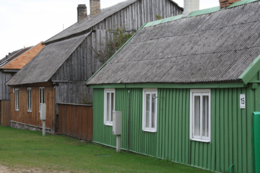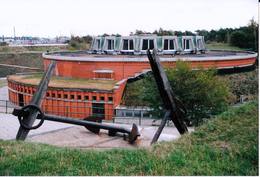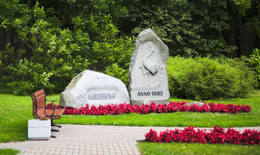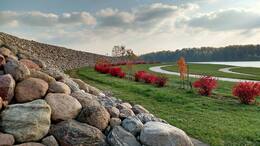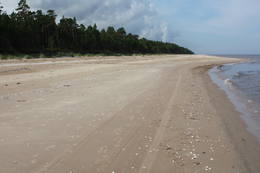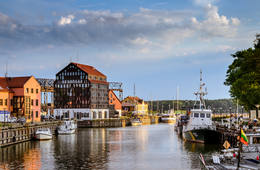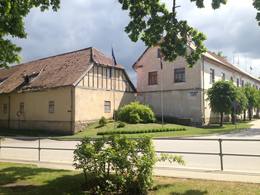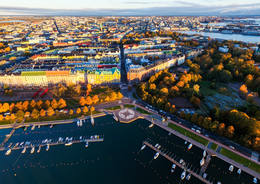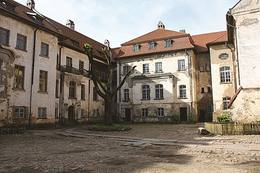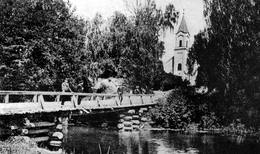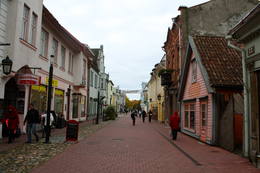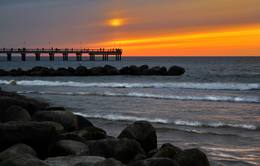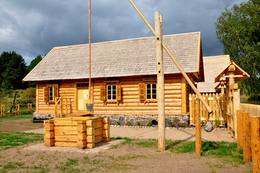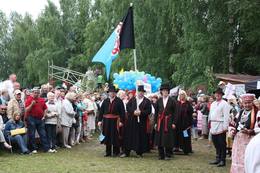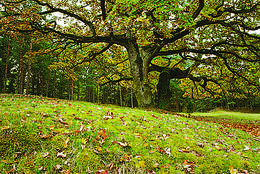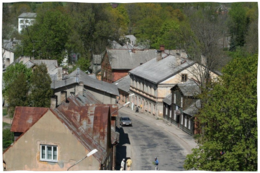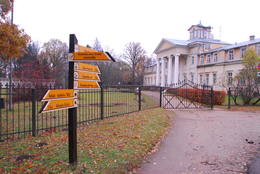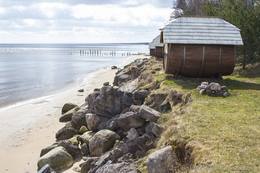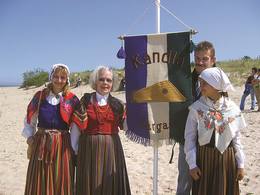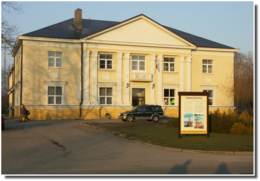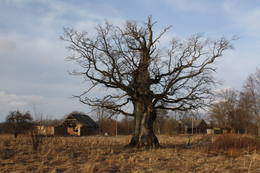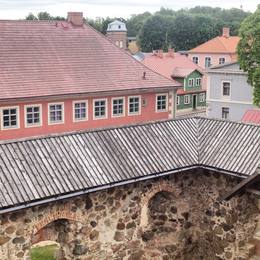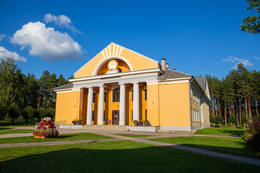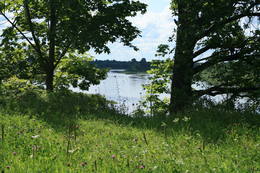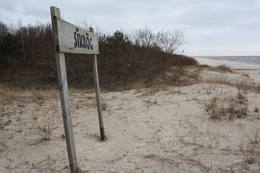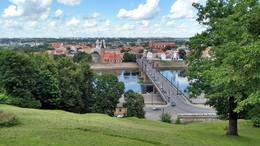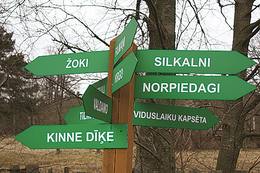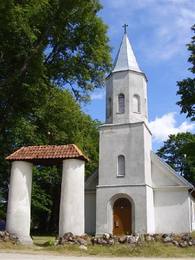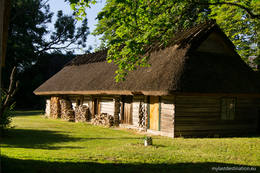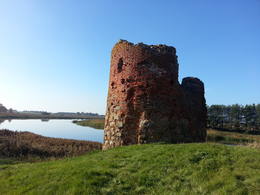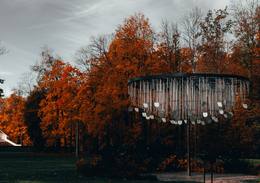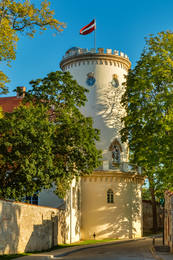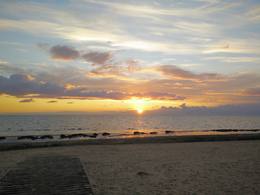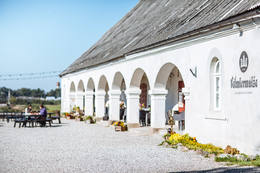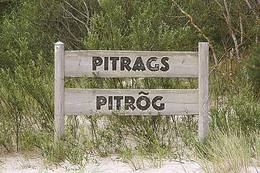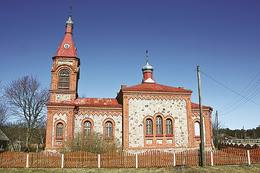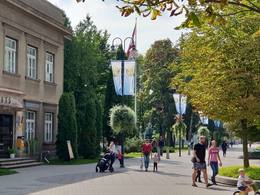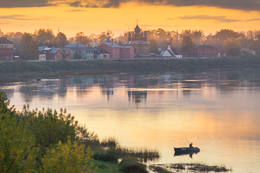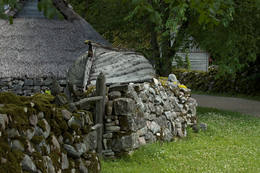Vēsturiskie un mūsdienu centri
| Pārskats | Detaļas |
|---|---|
|
Latvija
PāvilostaPāvilosta ir salīdzinoši jauna pilsēta, kas izvietojusies pie Sakas ietekas Baltijas jūrā. Tiesa, viduslaikos jūras kuģu osta bija 6 km attālumā no jūras - Tebras un Durbes upju satekas vietā. Nozīmīgs periods ostas dzīvē bija hercoga Jēkaba valdīšanas laikā, kad te piestāja jūras kuģi. Poļu-zviedru kara rezultātā Sakas ostu nācās slēgt. Mūsdienās redzamā osta Sakas grīvā veidojās 19. gs. vidū pie t.s. Āķagala zvejniekciema. Āķagala ielu plānojums ir regulārs un katra no tām izved vai nu jūras krastā, vai atduras pret Dzintaru ielu Sakas upes labajā krastā. 1878. g. padziļināja upes grīvu un uzbūvēja molus. Te būvēja divmastu burukuģus. Pasaules kari iznīcināja kuģu floti, taču zvejniecības tradīcijas allaž tika turpinātas. 1991. g. apdzīvotā vieta ieguva pilsētas statusu. Mūsdienās Pāvilosta ir pazīstama kā populāra burātāju un vējdēļsērfotāju, kā arī vasaras atpūtnieku vieta. Burātājus gaida jahtu osta. |
|
|
Latvija
VentspilsOstas pilsēta. Vecpilsētā saglabājies senais ielu tīklojums. 19. gs. koka apbūve Ostgalā. Ostas ielas promenāde ar Livonijas ordeņa pili, kuģīti „Hercogs Jēkabs”, Kr. Valdemāram veltīto pieminekli un mazām arhitektūras formām. Ventspils ir Lībiešu krastam tuvākā lielākā pilsēta, kur mūsdienās darbojas Līvu savienības Ventspils nodaļa, tiek rīkoti lībiešu kultūras pasākumi, darbojas lībiešu ansamblis „Rāndalist”, un turpat netālajā Tārgalē - lībiešu ansambļi „Kāndla” un „Piški kāndla”. |
|
|
Lietuva
Palūše (Palūšė)Palūšē atrodas nacionālā parka administrācija (izveidota neliela ekspozīcija) un tūrisma informācijas centrs, kempings, nesen atjaunotā laivu bāze un viens no biežāk apmeklētajiem parka objektiem – Palūšes baznīca (Palūšės bažnyčia), kas celta 1757. gadā. 2008. g. No dievnama apkārtnes paveras jauks skats uz Lūšu (Lūšiai) ezeru, īpaši saulrietos, kad baznīca iegūst teiksmainu nokrāsu. Blakus baznīcas žogam aug vecais Palūšes ozols. Uzskata, ka tā vecums varētu būt ~ 350 – 400 gadi. |
|
|
Lietuva
Kopgalis (Kopgalis) un Smiltīne (Smiltynė)Kopgalis atrodas Kuršu kāpu ziemeļdaļā iepretim Klaipēdas ostai. Te meklējami vairāki nozīmīgi un populāri Lietuvas un pat Baltijas mēroga tūrisma objekti. Kopgalis kopš seniem laikiem ir bijusi militāri un stratēģiski svarīga vieta, tādēļ 1866. g. prūšu militāristi šeit uzsāka vērienīga cietokšņa būvi, kura uzdevums bija Klaipēdas ostas aizsardzība. 2. pasaules kara laikā cietoksni uzspridzināja, bet 1979. g. uzsāka tā restaurāciju, izveidojot Baltijas valstīs vienīgo Jūras muzeju. Muzeja iespaidīgajā akvārijā ir apskatāmas Baltijas u.c. pasaules jūru un okeānu zivis, bet gar tā malām ir izvietota ekspozīcija. Apmeklētājus īpaši priecē graciozie dažādu sugu pingvīni un roņi to barošanas laikā. Vecajos Kopgaļa cietokšņa pulvera pagrabos ir izvietota Lietuvas kuģniecības tēmai veltīta ekspozīcija, bet uz bastioniem – seno ieroču kolekcija. Turpat atrodas Baltijas valstīs vienīgais Delfinārijs (no 1994. g.), kurš ir pazīstams ar delfīnu priekšnesumiem un reiterapijas kursiem. No Delfinārija gar Kuršu jomas krastu (lieliski Klaipēdas ostas skati!) var doties līdz Kuršu kāpu ziemeļu galam, kur atrodas mols – iecienīta makšķerēšanas vieta. Pretējā krastā ir redzama 1945. g. celtā 44 m augstā (pēc rekonstrukcijas 1953. g.) Klaipēdas bāka. Dienvidos no Jūras muzeja atrodas Kuršu kāpu nacionālā parka administrācija (Smiltynės gatve 11) un nacionālā parka apmeklētāju centrs, kurā apskatāms neliels Dabas muzejs. 100 m dienvidos no tā bijušā zvejniekciema vietā slejas etnogrāfiska zvejnieku sēta ar dzīvojamo un saimniecības ēkām, kā arī četrām oriģinālām zvejnieku laivām – no mazas zvejas laivas līdz pat lielajam kurēnam (burulaiva). Mazliet tālāk uz milzu podestiem ir novietoti trīs oriģinālie kuģi, ar kādiem jūrā zvejoja Padomju laikā. No Jūras muzeja ~ kilometru gara krasta promenāde aizved līdz Smiltīnei, kur kājāmgājēji un riteņbraucēji ar prāmi var pārcelties uz Klaipēdu. Autobraucējiem ir jādodas uz otru prāmi, kas atrodas 2 km dienvidos no Smiltīnes. |
|
|
Latvija
GrobiņaViena no vecākajām Latvijas apdzīvotajām vietām, jo laikā no 7.–9. gs. (pēc citiem avotiem: 4.–10. gs.) te atradusies lielākā zināmā skandināvu tirgotāju un karavīru kolonija tagadējās Baltijas teritorijā. Gotlandes un Zviedrijas ieceļotāji apmetni ierīkoja tajā laikā kuģojamās Ālandes upes labā krasta pakalnā – Skābaržkalnā. Uzskata, ka tieši šeit atradusies 9. gs. hronikās pieminētā kuršu Jūrpils (Seeburg). Pilsētas senākā apbūve izveidojusies ap Lielo ielu, kā arī ap Saules |
|
|
Latvija
LikteņdārzsAtrodas dienvidos no Kokneses uz salas, ko apņem Pļaviņu HES ūdeņi (ir savienojums ar krastu). Fundamentālā brīvdabas objekta izveides mērķis ir to Latvijas iedzīvotāju piemiņa, kuri ir cietuši no totalitāriem režīmiem. Pirmos darbus šeit uzsāka 2008. gadā. Dārza ainavas projekta autors ir Japānas ainavu arhitekts Shunmyo Masuno. Kaut arī dārzs ir tapšanas stadijā, tas jau ir kļuvis par populāru tūrisma objektu. Ir izveidota pirmā pastāvīgā ēka - Skatu terase - ar skatu uz Kokneses pilsdrupām un luterāņu baznīcu. Tas nozīmē, ka, atbraucot pēc kāda laika, šeit atkal būs apskatāms kas jauns. Ikviens ir aicināts vest un atstāt arī savu akmeni šajā mūsu tautai nozīmīgajā vēstures piemiņas vietā. |
|
|
Lietuva
Jodkrante (Juodkrantė)Sens kursenieku zvejniekciems, kas vēstures avotos ir minēts 1429. g. Pirms 2. pasaules kara Jodkrante bija Eiropas mērogā iecienīts kūrorts, kas savas tradīcijas nav zaudējis arī mūsdienās. Par to liecina sakoptā vide un izcilā ainava (Kuršu kāpu ciemi Baltijas mērogā unikāli ar savu arhitektonisko vidi!) ar savdabīgajiem mazstāvu koka namiem, kuros izveidoti nelieli viesu un atpūtas nami. Jodkrantē var apmeklēt vairākus interesantus objektus – lielisku promenādi Kuršu jomas krastā, kas stiepjas visa ciema garumā ar akmens skulptūru brīvdabas ekspozīciju „Zeme un ūdens" (tapusi 1995. g.), Lietuvas mākslas muzeja izstāžu zāli, luterāņu baznīcu (1885. g.), vēja rādītāju galeriju un Raganu kalnu. |
|
|
Latvija
Ventspils OstgalsPilsētas rajons dienvidos no Ventas grīvas, kura mūsdienās redzamā mazstāvu koka apbūve sāka veidoties 19. gs. vidū. Ostgala pirmsākumi meklējami 1836. g., kad Krievijas valdība, solot priekšrocības, aicināja apkārtnes zvejniekus apdzīvot smilšaino un kustīgo kāpu pārņemto piekrastes daļu. Ostgals ir atzīts par valsts nozīmes pilsētbūvniecības pieminekli. |
|
|
Latvija
Ģipka1869. g., dažus gadus pēc Ainažu jūrskolas dibināšanas, Ģipkā tika dibināta pirmā jūrskola Kurzemē. Šī bija 2. kategorijas jūrskola, kurā sagatavoja tālbraucējus stūrmaņus un tuvbraucējus kapteiņus. 1894. g. jūrskolu pārcēla uz Mazirbi. Pirms jūrskolas atvēršanās šajā ēkā no 1860. g. darbojās skola, bet 1867. g. speciāli jūrskolai, ēkai tika uzcelts otrais stāvs. Tā ir saglabājusies līdz pat mūsdienām un pārveidota par dzīvojamo māju. Skola (Ģipkā un Mazirbē) savas pastāvēšanas 28 gados devusi vairāk kā 200 profesionālu jūrnieku un tai bija liela nozīme kuģu būves veicināšanā piekrastes lībiešu ciemos. (Avots: Rojas TIC) |
|
|
Latvija
SmilteneLīdz 13. gs. Smiltenes novads ietilpa latgaļu apdzīvotajā Tālavas zemē. Pēc krustnešu invāzijas to ieguva Rīgas arhibīskaps, stāvajā Abula upes krastā 1370. g. uzceļot mūra pili. Sekojoši kari un epidēmijas nesaudzēja ne apdzīvotās vietas apbūvi, ne arī iedzīvotājus. Tagadējās pilsētas aprises sāka rasties 19. gs. beigās līdz ar Smiltenes muižas īpašnieka firsta Līvena aktīvo darbību. Līdz 1. pasaules karam Smiltenē darbojās kokapstrādes fabrika, hidroelektrostacija (1901. g., pirmā Baltijā) u.c. uzņēmumi. 1944. g. vācu karaspēkam atkāpjoties, ugunsgrēka laikā aizgāja bojā liela daļa Smiltenes vēsturiskās apbūves. |
|
|
Latvija
SiguldaSiguldas iepazīšanu var sākt ar Siguldas pilsdrupu apmeklējumu. Pils celtniecību uzsāka Zobenbrāļu ordenis 1207. g., bet 1236. g. to pārbūvēja Livonijas ordeņa vajadzībām. Siguldas pils stipri cieta 16. gs. otrās puses un 17. gs. sākuma karos. Ziemeļu kara laikā to nodedzina un vairāk neatjauno. Šodien ir apskatāms pils konventa ēkas dienvidrietumu korpuss un galveno vārtu tornis, aiz kura atrodas iekšējā priekšpils ar brīvdabas estrādi, no kuras paveras iespaidīgs skats uz Gaujas senleju. Šobrīd notiek pilsdrupu rekonstrukcijas darbi. Dienvidos esošās Siguldas Jaunās pils celtniecība (īpašnieks - kņazs Kropotkins) norisinājās laikā no 1878. - 1881. g. No 1923. - 1940. g ēkā bija Rakstnieku pils, bet Padomju gados - kardioloģijas sanatorija. Kopš 2003. g. te atrodas Siguldas novada dome. Muižas kompleksā ir saglabājusies koka dzīvojamā ēka (19. gs. vidus), kurā atradās Kropotkina ģimenes mājas, klēts (18. - 19. gs. mija), dārznieka māja (19. gs.) un mūra žogs (19. gs.). Ja no Jaunās pils dosimies ziemeļaustrumu virzienā, pēc nepilniem 2 km nonāksim pie Vējupītes gravas. Tajā apskatāma seklā (3,6 m), bet augstā (6,1 m) Pētera ala un dziļā Pūču grava ar Kraukļupīti. Abu upīšu gravu saskares vietā paceļas Satezeles pilskalns (plakums 90 x 75 m), kur 13. gs. sākumā atradās līvu zemes vadoņa (vecākā) - Dabreļa ozolkoka pils. Netālu meklējama Kraukļu aiza - Vējupītes kreisā krasta sānu grava ar 11 m augstām smilšakmens sienām un 5,2 m dziļā Kraukļu ala. Vējupītes gravas un Gaujas senlejas saskares vietā slejas Paradīzes (Gleznotāju) kalns - ļoti ainaviska vieta, kas gleznota un fotografēta kopš seniem laikiem. Līdz Paradīzes kalnam var nokļūt arī ar elektromobili. Siguldas rietumdaļā var apmeklēt Panorāmas ratu (darbojas vasaras laikā) un Gaisa trošu ceļu (tramvajs) - Baltijas valstīs vienīgo (celts 1969. g.) šāda tipa transporta līdzekli. Tā nesošā trose stiepjas 1060 m garumā un bez atbalstiem savieno Gaujas senlejas krastus starp Siguldu un Krimuldu ~ 40 m augstumā virs Gaujas. Te paveras izcili skati! Siguldas dienvidrietumu daļā var aizstaigāt līdz varenajai Beites kraujai, kuru pāršķeļ dziļa strauta grava. Gravas rietumu pusē meklējams Ķeizarskats, kas atrodas ~ 67 m virs Gaujas līmeņa ar labu skatu uz Krimuldu un Turaidas pili. Skatu vietu šeit iekārtoja jau 1862. g. kad Siguldā viesojies Krievijas cars Aleksandrs II. Gravas austrumu pusē novietots no koka veidotais Ķeizarkrēsls. |
|
|
Latvija
Lielie MuļķiApdzīvota vieta ~ 1 km dienvidos no Daugavpils – Krāslavas (A 6) ceļa, kas pazīstama ar savu neparasto nosaukumu. Interesanti, ka vietvārds saistīts arī ar iedzīvotāju uzvārdiem, ko var redzēt tāda paša nosaukuma kapos. Ciema apkaimē pazīstams ir Lielo Muļķu svētavots, kuru gan nezinātājam ir grūti atrast, tādēļ ieteicams izmantot vietējā gida pakalpojumus, apvienojot šīs vietas izziņu ar biškopības saimniecības „Cīruļi” apskati. |
|
|
Latvija
JaunpilsJaunpils attīstība ir saistīta ar Livonijas ordeņa pili, kas līdz mūsdienām gandrīz nav mainījusi savu būvapjomu un ārējo izskatu. Laikā no 1561. - 1919. g. tā piederējusi baronu Reku dzimtai. 1905. g. pili dedzināja, bet vēlāk atjaunoja arhitekta V. Bokslafa vadībā. Būtiskākus pils restaurācijas darbus uzsāka 20. gs. 60. gados. Tagad pilī ir apskatāms muzejs, bet gardēži pils krodziņā var nobaudīt viduslaiku ēdienus. |
|
|
Latvija
Līgatnes papīrfabrikas ciemata vēsturiskais centrsLīgatnes vēsture ir nesaraujami saistīta ar papīrfabriku, kas ir vienīgais šāda veida funkcionējošais uzņēmums Latvijā (apskatāms ar gidu). 19. gs. beigās un 20. gs. sākumā fabrikas strādniekiem Līgatnē uzcēla dzīvojamās ēkas, skolu, dzemdību namu, slimnīcu, klubu, viesu namu un citas ēkas, kas ir saglabājušās līdz šodienai. Interesantas ir pagrabalas (> 200), kuras vēl joprojām izmanto kā mantu noliktavas un dārzeņu glabātuves. |
|
|
Latvija
Preiļi15. gs. Preiļu muiža kļuva par grāfu Borhu dzimtas īpašumu. Borhi šeit saimniekoja līdz 19. gs. 60. gadiem. Pati pilsēta izveidojās 19. gs. pirmajā pusē, saplūstot Preiļu muižai, ciemam un brīvciemam - amatnieku un tirgotāju apmetnei. 19. gs. Preiļos uzbūvēja greznu pili un iekārtoja ainavu parku. Mūsdienās Preiļi ir nozīmīgs Latgales ekonomiskais centrs (siera un šūšanas ražotnes), kas kopj savas folkloras, amatniecības un katolicisma tradīcijas. Īpaši ieteicama ir ekskursija pa Preiļiem TIC darbinieces Irēnas Kjarkužas pavadībā. |
|
|
Latvija
AlsungaKā senā Alšvanga šī apdzīvotā vieta pirmo reizi tika pieminēta 1231. gadā pāvesta vicelegāta Alnas Balduīna līgumā ar kuršiem. Livonjas ordenis te saimniekoja līdz 1561.gadam, bet no 1573.-1738.gadam ordeņa pils pieder no Pomerānijas nākušo fon Šverinu dzimtai. Tieši Šverinu dzimtas valdīšanas laikā Alsungā uzceļ mūra baznīcu Svētā erceņģeļa Miķeļa godam un uzsāk vietējo iedzīvotāju pievēršanu katoļticībai. Alsunga kļūst par visas Kurzemes katoļu centru, tās iedzīvotāji par suitiem (Šverinu svīta). |
|
|
Igaunija
Tartu vecpilsētaIzvietojusies Emajõgi upes kreisajā krastā, Doma kalna piekājē. Klasicisma stilā celtās vecpilsētas centrālā vieta ir Rātslaukums ar Rātsnamu un strūklaku „Studentu skūpsts” (pilsētas simbols). |
|
|
Igaunija
TallinnIgaunijas galvaspilsēta. Vecpilsēta (UNESCO Pasaules kultūras mantojuma sarakstā) - izcils viduslaiku (14. – 15. gs.) apbūves piemineklis. Bijusī Hanzas pilsēta. |
|
|
Latvija
Lielirbe (Īra)Ciems atrodas pie Irbes (Dižirve, Īra) upes ietekas jūrā, abos tās krastos („jūrspuse” un „zemspuse”). Irbe pirmoreiz minēta 1310. g. robežlīgumā starp Kurzemes bīskapu un Rīgas domkapitulu, bet Lielirbes (Irvemünde) vārds pirmoreiz ierakstīts 1387. g. šķīrējtiesas dokumentā. 19. gs. beigās Lielirbes sīkosta bija aktīvs kokmateriālu tirdzniecības un transporta centrs. 19. gs. beigās un 20. gs. sākumā te uzbūvēts lielākais burinieku skaits Kurzemes rietumkrasta ciemos. 1939. g. ciemā bija ap 300 iedzīvotāju, vairāk kā 70 māju un baptistu baznīca (tagad Ventspils Brīvdabas muzejā). Ciemam cauri kursēja mazbānītis, darbojās pasta un telegrāfa kantoris, divi pārtikas veikali, 1. pakāpes pamatskola, koris un pūtēju orķestris. Lielirbe bija viens no lielākajiem ciemiem, kas izzuda pēc Otrā pasaules kara. Lielirbē dzimusi kultūrvēsturniece Valda Marija Šuvcāne (1923 - 2007), kuras darbu turpina viņas meita Baiba Šuvcāne, rakstot nozīmīgus darbus par Lībiešu krasta dzīvi. Līdz 2019. g. pāri Irbes upei plānots atjaunot trošu tiltu. |
|
|
Somija
HelsinkiHelsinki is the capital of Finland and the biggest city in Finland. It offers a lot to see as it is seaside city surrounded by islands but city itself is full of wonderful parks. This city has everything to attract all kinds of people - from architecture and culture to nature and even has wide range of places where to enjoy night-time Helsinki. |
|
|
Latvija
OvišiOviši (lībiski – Paţikmō) Sena apdzīvota vieta. 20. gs. 30. gados te bija 50 sētas, bet 1990. g. - tikai desmit. Ovišos dzimis lībiešu izcelsmes zinātnieks - entomologs Kārlis Princis (1893 - 1978), kurš 1944. g. emigrēja uz Zviedriju. Ovišu bāka (1814. g.) ir vecākā joprojām funkcionējošā Latvijas bāka - 38 m augsta. No tās augšas paveras skaists skats. Saglabājusies 1905. g. bākas darbinieku ēka, kurā savulaik iekārtoja mazbānīša staciju. Palīgēkā izveidots Ovišu bākas muzejs. Netālu no bākas – metāla Austras koks. Iepretim Ovišragam – laba putnu vērošanas vieta.
|
|
|
Latvija
DundagaDundagas barons savulaik bijis viens no lielākajiem zemju īpašniekiem Kurzemē, tādēļ 19. gs. otrajā pusē ap muižu izveidojās saimnieciskās un sabiedriskās dzīves centrs. Dundagas centrālā laukuma dominante ir ūdenstornis, aiz kura sākas Dakterleja, kur no 1844. līdz 1854. g. doktorātā strādājis viens no pirmajiem latviešu tautības ārstiem un valodnieks J. Bārs. Līdz pat 20. gs. 60. gadiem no Dundagas cauri Mazirbei un zvejniekciemiem uz Ventspili kursēja mazbānītis. Mūsdienās Dundaga piesaista tūristus ar savu iespaidīgo pili, luterāņu baznīcu, Krokodila skulptūru, keramiķes Eizenbergas darbnīcu u.c. objektiem. |
|
|
Lietuva
Viļņa (Vilnius)Lietuvas galvaspilsēta. Viena no lielākajām Austrumeiropas vecpilsētām (iekļauta UNESCO Pasaules kultūras mantojuma sarakstā), kurā pārstāvēti dažādi arhitektūras stili - klasicisms, baroks, gotikas, renesanses u.c. |
|
|
Latvija
Pēterupes ciemsPēterupes labajā krastā atrodas Saulkrastu vēsturiskā teritorija Pēterupes ciems. Domājams, ka ciems sācis veidoties ap lūgšanu namu (kapelu) tā sauktajos zviedru jeb katoļu laikos. Lūgšanu nams bija nosaukts apustuļa Svētā Pētera vārdā, tādēļ arī upei un ciemam dots tāds nosaukums. Pēterupes ciemu varam uzskatīt par vecāko ciemu Saulkrastu novadā. Pēterupē vecākie laikmeta liecinieki ir Mācītājmuiža, Pēterupes ev.luteriskā baznīca, doktorāts un vecais koka apbūves centrs. (Avots: Saulkrastu TIC) |
|
|
Igaunija
PärnuPopulārākais Igaunijas kūrorts ar plašu atpūtas un SPA piedāvājumu. Viena no retajām Igaunijas smilšainajām pludmalēm un siltā (sekls) Pērnavas līča ūdeņi. Vecpilsēta ar galveno gājēju ielu – Rüütli tee. |
|
|
Latvija
ĶemeriĶemeri (Kemmer) pirmo reizi rakstiskajos avotos ir pieminēti 1561. g. 18. gs. otrajā pusē un 19. gs. sākumā ir labi zināmas Ķemeru sēravotu ūdeņu un purvu dūņu dziednieciskās īpašības, tādēļ uz šejieni ārstēties dodas Kurzemes augstāko aprindu pārstāvji. Viesus uzņem vietējie mežsargi. Šajā laikā notiek pirmās dūņu peldes. Jūrmalas un Ķemeru peldvietu attīstību uz kādu brīdi pārtrauc 1812. g. Tēvijas karš. Divas desmitgades vēlāk - no 1833. līdz 1835. g. Ķemeru labumus izmēģina Baltijas ģenerālgubernators grāfs K. M. Pālens, kurš vēršas pie Krievijas cara Nikolaja I pēc atbalsta kūrorta tālākai attīstībai. Lūgums tiek atbalstīts un 1836. g. cars atvēl 700 ha valsts zemes un piešķir 100 000 rubļu dziedinātavas celtniecībai un ceļa bruģēšanai no Ķemeriem līdz Slokas – Tukuma lielceļam. Divus gadus vēlāk (1938. g.) atklāj pirmo valsts peldu iestādi. Šo arī uzskata par kūrorta dibināšanas gadu. Kūrorta slava izplatās visā Krievijas impērijā un tas kļūst aizvien populārāks. Vairākos posmos tiek uzsākta Ķemeru ainavu parka izveide, kas ir nozīmīga kūrorta sastāvdaļa. 19. gs. vidū un otrajā pusē kūrorta tālāku attīstību sekmē gan tvaikoņu, gan arī 1877. g. atklātā dzelzceļa satiksme no Rīgas līdz Tukumam. 1912. g. atklāj tiešo dzelzceļa līniju Ķemeri – Maskava. Īsi pirms 1. pasaules kara pacientu skaits sasniedz 8300 cilvēkus gadā. 1. pasaules kara frontes līnija Ķemeru purvā turas vairākus gadus un kūrorts tiek pamatīgi izpostīts. Neskatoties uz to, pēc kara notiek strauja tā izaugsme un Ķemeri kļūst par iecienītu Rīgas iedzīvotāju atpūtas vietu un vienu no modernākajām Eiropas dziednīcām. 1924. g. Ķemeros uzceļ jaunu peldiestādi ar dūņu vannām, kas tajā laikā ir viena no modernākajām Eiropā, bet 1936. g. Valsts Prezidents Kārlis Ulmanis atklāj vienu no izcilākajām pirmās neatkarīgās Latvijas laika celtnēm – viesnīcu „Ķemeri". Arī pēc 2. pasaules kara – Padomju laikos kūrorts ievērojami paplašinās un tā apkārtnē izveido gandrīz 10 sanatorijas, kur strādā ~ 100 ārstu. 1971. g. Ķemeriem piešķir Vissavienības nozīmes kūrorta statusu. Laikā no 1975. – 1985. g. Ķemeros top lielākā no sanatorijām – Līva (sākotnēji - Latvija), kurai ir divi vienpadsmit stāvu korpusi. Līvā vienlaikus varēja ārstēties līdz 1200 pacientu, bet gada laikā – pat līdz 140 000 pacientiem. Sanatoriju slēdz 20. gs. deviņdesmito gadu sākumā kā nerentablu. Līdz pat 1994. g. Ķemeros darbojas piecas sanatorijas: „Čaika", „Daugava", „Dzimtene", „Ķemeri" un „Līva" (Latvija) un kūrorta poliklīnika „Ķemeri". Vēlāko laiku var uzskatīt par sava veida Ķemeru kā plaša mēroga ārstniecības kūrorta norietu. |
|
|
Lietuva
PalangaPalanga is known to be the biggest by-the-sea resort in Lithuania because of its seacoast's main attractions - dunes and white sand. And because Palanga is a resort there are plenty of cafes, restaurants, bars and more for those who would like to enjoy a meal or a drink, for those who like active sport - there is possibility to cycle, go horseback riding, swim and much more. |
|
|
Latvija
JelgavaPilsētai nozīmīgākais periods ir saistāms ar laiku no 1561. - 1795. g., kad Jelgavas novads ietilpst Kurzemes un Zemgales hercogistes sastāvā. Kad Jelgava iegūst hercoga rezidences (1567. g.) un hercogistes galvaspilsētas (1616. g.) statusu, sākās strauja pilsētas attīstība, kas visaugstāko punktu iegūst hercoga Jēkaba valdīšanas laikā. Pēdējo divu Kurzemes hercogu - Ernsta Johana Bīrona un viņa dēla Pētera valdīšanas laikā tiek dibināta (1775. g.) Pētera akadēmija (Academia Petrina) - pirmā Latvijas augstskola, 1816. g. dibināta Kurzemes Literatūras un mākslas biedrība, 1822. g. iznāk pirmā avīze latviešu valodā "Latviešu Avīzes", 1802. g. top Latvijā pirmā teātra ēka, bet 1898. g. - pirmā muzejam domātā ēka. 1937. g. Jelgavas pilī izvieto Latvijas lauksaimniecības kameru, bet pēc diviem gadiem atklāj Jelgavas Lauksaimniecības akadēmiju. 1944. g. vasarā gāja bojā gandrīz visa pilsētas vēsturiskā apbūve un mākslas vērtības. Pēc 2. pasaules kara Jelgavu atjaunoja. Tikko kā ir atjaunots arī Sv. Trīsvienības baznīcas tornis, kurā šobrīd ir izveidots viens no Latvijas labākajiem interaktīvajiem muzejiem (ļoti draudzīgs ģimenēm ar bērniem). |
|
|
Latvija
IecavaNeliela pilsētiņa ceļā no Rīgas uz Bausku. Pilsētas vārds rakstiskajos avotos ir pieminēts 1492. g. Apskatāma luterāņu baznīca un bijušās muižas parks. |
|
|
Latvija
Bauskas rātslaukums un rātsnamsJau 1615. g. Kurzemes hercogs Frīdrihs Ketlers (1569. – 1642.) piešķīra Bauskas pilsētai privilēģiju jauna rātsnama celtniecībai, kas arī tika īstenots, un 17. gs. Tirgus laukums lepojās ar hercogistē lielāko rātsnamu. Līdzekļu trūkuma dēļ 1852. g. nojauca tā torni, bet 1871. g. – otro stāvu. 2011. g. beigās tika pabeigta jaunā rātsnama celtniecība, un tagad Bauska var lepoties ar jaunu, izcilu tūrisma objektu, kas apskatāms arī no iekšpuses. Atjaunotajā rātsnamā ir iespēja nosvērties un nomērīties senajās mērvienībās – olektīs, pēdās, pudos, mārciņas un par to saņemt atbilstošu sertifikātu. |
|
|
Latvija
Slutišķu sādža un Slutišķu vecticībnieku lauku sētaIzskata ziņā – visnotaļ etnogrāfisks ciems, kam ir sādžas plānojums un Latgales novadam raksturīgās ēkas ar apdarinātiem logiem un ažūrām fasādēm. Slutišķu vecticībnieku mājā ir izveidots muzejs (Naujenes novadpētniecības muzeja filiāle), kurā var iepazīt vecticībnieku kultūrvidi un tradīcijas. No blakus esošā Daugavas ielejas krasta paveras viena no neparastākajām Latvijas kultūrainavām. Tiem, kam patīk doties garākos pārgājienos, var aizstaigāt līdz aptuveni kilometru tālajai Slutišku kraujai, no kuras paveras ne mazāk iespaidīgi skati. Vasara 2018.
|
|
|
Igaunija
Mulgimā vēsturiskais reģionsMulgimā jeb Mulgi ir kulturvēsturisks reģions Igaunijas dienvidos. Par Mulgimā tika uzskatīta Viljandi apriņķa daļa, kas atrodas uz dienvidiem no Raudnas un Tenasilmas upēm. Senākos laikos Mulgi lauksaimnieki bija slaveni ar savu aso prātu un mērķtiecību, kas palīdzēja pārpirkt zemes no vācbaltu muižniekiem un kļūt par bagātiem lauksaimniekiem. Mulgi kultūras ikonas - dialekts, labi zināmā vīriešu garā melnā jaka un tradicionālā Mulgi putra - ir saglabājušās līdz pat šai dienai.
|
|
|
Latvija
DobeleDobeles vārds vēstures avotos pirmo reizi minēts 1254. g. Dobele bija viena no visvairāk nocietinātajām zemgaļu vietām, tādēļ laikā no 1279. - 1289. g. pārdzīvoja sešus vācu krustnešu uzbrukumus. 1289. g. zemgaļi tomēr bija spiesti atkāpties. 1335. g. iekarotāji zemgaļu pils vietā uzsāka jaunas mūra pils celtniecību. Bērzes pretējā kreisajā krastā sāka veidoties tirgotāju un amatnieku miests. Pilsēta ļoti cieta Ziemeļu kara un tam sekojošā mēra laikā. Nozīmīgs notikums pilsētas saimnieciskajā dzīvē bija 1927. g., kad izbūvēja Liepājas-Glūdas dzelzceļa līniju. Pēc 2. pasaules kara Dobelē un tās apkaimē ieradās padomju militāristi, kas izbūvēja vienu no lielākajiem PSRS tanku poligoniem „Dobele-2". Tagad Dobeles apceļotājiem tiek piedāvāts interesants apmeklējamo objektu klāsts. |
|
|
Lietuva
Strazdi (Strazdai)Ja mērķis ir savākt pilnvērtīgu etnogrāfisko ciemu fotokolekciju, ir jāapskata Strazdi (no lietuviešu valodas strazdai tulkojumā nozīmē strazds), kas ir pavisam neliela apdzīvota vieta Balošas (Baluošas) ezera ziemeļu krastā. Strazdi pirmoreiz rakstos minēti 1783. g. un ciema nosaukums cēlies no kādas mežziņu dzimtas uzvārda. |
|
|
Latvija
Vaide (Vaid)Vēstures avotos minēta jau 1582. gadā. 1736. g. Dundagas vaku grāmatā minētas divas Vaides sētas - Lekši un Žonaki. Pēc tautas skaitīšanas datiem 1935. g. pavasarī Vaidē dzīvoja 106 cilvēki, tai skaitā 40 lībieši, 60 latvieši, daži igauņi un vācieši. 1939. g. Vaides ciemā bija 21 sēta. Vaides Lāžos dzima Nika Polmanis (1823 - 1903) - pirmais izglītotais lībietis un visu mūžu nodzīvoja lībiešu dzejnieks Alfons Bertholds (1910 - 1993), kurš blakus sētai augošajam dižozolam veltīja dzejoli. Ar Žonakiem saistīta plašā Bertholdu dzimta: lībiešu teicēja Marija Šaltjāre, jūras jahtu kapteinis Andrejs Bertholds (ASV), viņa dēls, bibliotēku zinātnieks - Artūrs Benedikts Bertholds (ASV), lībiešu dzejnieks Alfons Bertholds, lībiešu valodas zinātāji Paulīne Kļaviņa un Viktors Bertholds, Šveices ārsts Marsels Bertholds, pasaulslavenais pianists Arturs Ozoliņš (Kanādā) un Grizelda Kristiņa (1910 – 2013) – lībiešu valodas teicēja un dzejniece, kura bija pēdējā lībiešu valodas runātāja, kam tā bija dzimtā valoda. Ozolnieki arī saistās ar Bertholdu dzimtu – lībiešu tradīciju un valodas zinātāju Paulīni Kļaviņu (1918 - 2001) un viņas māti, - lībiešu teicēju Katrīnu Zēbergu. Paulīnes savāktā lībiešu etnogrāfisko priekšmetu kolekcija apskatāma Latvijas Etnogrāfiskajā brīvdabas muzejā – „Dēliņu” lībiešu sētas klētī. Vaides Purvziedos apskatāma mežsarga Edgara Hausmaņa meža dzīvnieku ragu kolekcija. |
|
|
Latvija
Papes ĶoņuciemsPape veidojoties no trim maziem zvejniekciemiem - Papes Priediengala, Papes un Papes Ķoņu ciema. Visi ciemi izstiepušies turpat piecu kilometru garumā līdztekus Baltijas jūras krasta līnijai. Papes Ķoņu ciems ir viens no diviem Latvijas zvejniekciemiem (otrs – Košrags), kas līdz mūsdienām (cik tas iespējams) saglabājis autentisku elpu. Te atrodas Latvijas Etnogrāfiskā brīvdabas muzeja filiāle Vītolnieki ar senu zvejnieku sētu, laivām un sadzīves priekšmetiem, ko vērts iepazīt gida pavadībā. Šobrīd ciemā notiek mūslaiku ēku būvniecība, tādēļ tas ar katru dienu zaudē savu mazskartību. Atrodas Papes dabas parkā. |
|
|
Latvija
KūdraNeliela apdzīvota vieta, kuras apkārtnē jau izsenis iegūta kūdra un ārstniecības dūņas, kas izmantotas Ķemeru kūrortā. Kūdrā atrodas padomju laikā celtā dzelzsbetona rūpnīca, kura nodrošināja ar būvniecības materiāliem tagadējo Kauguru mikrorajonu.
|
|
|
Lietuva
Žemaišu Kalvarija (Žemaičių Kalvarija)Pirmo reizi vēstures avotos 1253. g. šī vieta ir minēta kā kuršu apdzīvota apmetne. Laikā no 1637. – 1639. g. te uzcēla pirmās 19 kapelas – t.s. „Krusta ceļa stacijas", kas atgādināja Jeruzalemes Krusta ceļu. Kopš tā laika Žemaišu Kalvarija ir pazīstama kā nozīmīgs svētceļnieku galamērķis. Dažas no Krusta ceļa kapelām ir veidotas 17. – 18 gs., bet citas – 19. gs. Jāatceras, ka vēl pavisam nesen – Padomju laikos svētceļniekus nežēlīgi vajāja un represēja. Mūsdienās pilsētā ir izveidots 21 svētceļnieku „pieturas punkts". Te ik gadu (parasti no 2. – 12. jūlijam) notiek Žemaišu Kalvarijas katoļu draudzes svētki, kas pulcina daudz ļaužu no dažādām Eiropas valstīm. Iespaidīgā katoļu bazilika ir slavena ar Vissvētākās Jaunavas Marijas Katoļu Ģimeņu Karalienes gleznu, kas 17. gs. atvesta no Romas. Tai piedēvē brīnumdarītājas spējas. Interesants ir pilsētas ielu tīklojums, kas atgādina 9. – 13. gs. apdzīvotas vietas ielu plānojumu. Noteikti apskatāms iespaidīgais Žemaišu Kalvarijas pilskalns, kas slejas mazās Varduvas (Varduva) upītes krastā. |
|
|
Latvija
ValdemārpilsValdemārpils ir maza un klusa pilsētiņa, kas izvietojusies garā Sasmakas ezera krastā. Jau 17. gs. sākumā uz Sasmakas muižas zemes izveidojās amatnieku un tirgotāju miests. 19. gs. vidū Kurzemes pilsētās dzīvoja daudz ebreju tirgotāju un amatnieku, tādēļ Sasmaku tolaik dēvēja par ebreju galvaspilsētu. 1926. g. pilsētu pārdēvēja par Valdemārpili. Pilsētas vēsturiskais centrs ar 19. gs. apbūvi ir pilsētbūvniecības piemineklis. Valdemārpilī apskatāma luterāņu un pareizticīgo baznīcas, bij. Valdemārpils sinagoga, K. Valdemāram veltītais piemineklis, kā arī izcilā Valdemārpils Elku liepa. |
|
|
Latvija
Kuldīgas vēsturiskais centrs ap AlekšupītiSavā ziņā unikāls un Baltijas valstīs vienīgais šāda veida 17. - 18. gs. mazpilsētas apbūves komplekss, kas izvietojies mazās Alekšupītes krastos. Dažviet upīte tek gar ēku sienām. Šī pilsētvide ar tiltiņiem radījusi apzīmējumu – „Latvijas Venēcija”. Interesantiem kultūras pieminekļiem bagātas ir Baznīcas, Liepājas, Kalna u.c. ielas. |
|
|
Latvija
Rēzekne"Latgales sirds", kur 9. - 12. gs. pacēlās nocietināta latgaļu pils. 1285. g. Livonijas ordenis latgaļu pils vietā uzsāka mūra pils celtniecību. Pēc Livonijas sabrukuma (Rēzekne Polijas sastāvā) pilsēta nīkuļoja. Ekonomiskā dzīve Rēzeknē atjaunojās 18. gs. otrajā pusē. Pēc Pēterburgas-Varšavas šosejas (1836. g.) un dzelzceļa (1861. g.) izbūves Rēzekne kļuva par Pēterburgas atpūtnieku galamērķi. 2. pasaules kara laikā pilsētas apbūve būtiski cieta. Mūsdienās pilsēta ir nozīmīgs Latgales reģiona ekonomiskais un kultūras centrs. |
|
|
Latvija
Madonas Saieta laukumsMadonas centrālais laukums, kas vēl 20. gs. sākumā bija tirgus laukums. Pēc apjomīgās restaurācijas tas ir kļuvis par ievērības cienīgu pilsētvides objektu. Laukuma ziemeļu pusē atrodas pilsētas un novada pašvaldība un Madonas novada TIC. |
|
|
Latvija
Kokneses pilsdrupasAtrodas uzpludinātās Daugavas un Pērses satekas vietā. To cēla Rīgas bīskapijas vajadzībām 1209. g. bijušās senlatviešu koka pils vietā. 14. gs. pils pagalmā bija uzbūvētas koka ēkas, kas bija piemērotas pastāvīgai dzīvošanai. 16. gs. uzcēla piebūves un divus apaļos torņus. 1701. g. šķietami nesagraujamo pili uzspridzināja sakšu karaspēks. Pie pilsdrupām darbojas apmeklētāju centrs, kur var izkalt viduslaiku monētu un noīrēt laivu braucienam pa Daugavu. Vērts doties pastaigās pa Kokneses parku (veidots 1900. g.), kurā apskatāmi 17. gs. zviedru lielgabali, viduslaiku kapu pieminekļi un atjaunotā strūklaka „Fauna galva”, kas 20. gs. 30. gados atradās netālu no Pērses ūdenskrituma (tagad zem ūdens). |
|
|
Latvija
Ventspils Tirgus laukumsTāpat kā Ventspils Rātslaukums, arī Tirgus laukums ir uzskatāms par pilsētas vēsturiskā centra nozīmīgu daļu, kura apkaimē ir saglabājies senais ielu plānojums. Kādreizējā Rātsnama vietā tagad slejas kariljonu zvana pulksteņu tornis. Tas zvana katru stundu, bet 12:33:44 un 00:33:44 ar īpašu melodiju ieskandina astronomisko Ventspils laiku. Tirgus laukumā ir aka, kas saulainā laikā darbojas arī kā Saules pulkstenis. Monētu automātā var izkalt īpašu piemiņas monētu. |
|
|
Latvija
KrimuldaKrimuldas luterāņu baznīcu uzskata par vienu no vecākajiem Latvijas dievnamiem. Tā sākotnēji celta 13. gs. sākumā drīz pēc Kubeseles iekarošanas un vēlāk daudzkārt pārbūvēta. Blakus baznīcai izveidots meditācijas labirints "Lilijas zieds". Kad 1217. g. pie Vīlandes kaujā krita lībiešu virsaitis Kaupo, tā pelnus pēc nostāstiem esot apbedījuši baznīcā. Par Kaupo kapa vietu tautā dēvē nelielu pauguru pie blakus esošās Runtiņupītes (Runtiņš), kuras labajā krastā atrodas ~ 7 m gara mākslīgi raktā Kubeseles jeb Runtiņala. Runtiņupītes kreisajā krastā slejas Kubeseles pilskalns. Pie baznīcas sākas Kubeseles dabas taka. Pa to var aiziet līdz Gaujai, kuras krastā iegūlis Lielais (Runtiņa) akmens. Turpat apskatāmi Gaujas plostnieku uzstādītie enkurkluči. Krimuldas viduslaiku pili (4 km austrumos no Krimuldas baznīcas) cēla 13. gs. otrajā pusē vietā, kur Gaujas senlejas labo pamatkrastu pāršķeļ dziļā Vikmestes grava. Pils (saimniekoja Rīgas domkapituls – Rīgas arhibīskapu padome) bija iespaidīga celtne, kuras plašo iekšpagalmu ietvēra 1,5 m biezs aizsargmūris. 1601. g. atkāpjoties, Krimuldas pili uzspridzināja zviedru karavadonis Heinrihs Līvens. Tagad ar mežu apaugušajā pilskalnā apskatāmas nelielas pilsdrupas. Pie tām atrodas Gaisa trosu ceļš un sākas Krimuldas Serpentīna ceļš. Netālu esošā Krimuldas muiža pirmoreiz rakstos ir minēta jau 15. gs. Tagad redzamo muižas pili būvēja 19. gs. neoklasicisma stilā (īpašnieks - firsts Līvens). 20. gs. 20 gados pēc pils atsavināšanas tā nonāca Latvijas Sarkanā Krusta īpašumā, kas izveidoja bērnu sanatoriju. Mūsdienās pilī atrodas rehabilitācijas slimnīca "Krimulda", bet no saimniecības ēkām ir saglabājušies muižas staļļi, kūts, kalpu, pārvaldnieka un t.s. Šveices māja, kā arī parks. Te piedāvā tematiskas ekskursijas. Ja pa Gauju brauksim ar laivu, tad tuvumā varēs aplūkot ap 15 m augstās Velnalas klintis. Tās var labi redzēt arī no pretējā - kreisā Gaujas krasta (izveidota atpūtas vieta). Klinšu vidusdaļā atrodas ap 19 m dziļā un 4,7 m augstā Krimuldas Velnala. Ja no Velnalas klintīm pa Gaujas labā pamatkrasta lejasdaļu dosimies Turaidas virzienā, skatam pavērsies ar smilšakmens atsegumiem bagātā Piķenes krauja. Tās piekājē ir izveidota ~ 1 km garā Piķenes bebra taka. Takas malā atrodas Mazā Velna ala (5 m gara) ar iztekošo Gudrības avotiņu, gan arī tikpat garā Aunapieres ala. Redzamas arī nelielas vecupes. |
|
|
Latvija
DaugavpilsPar Daugavpils dibināšanas gadu uzskata 1275. g.. Tas ir laiks, kad Livonijas ordeņa mestrs Ernests fon Ratceburgs Naujenes pilskalnā uzcēla Dinaburgas pili. Tā vairākkārt cieta lietuviešu un krievu iebrukumos, līdz 1577. g. pili nopostīja krievu karaspēks Ivana Bargā vadībā. Pēc šī notikuma Dinaburgu atjaunoja 17 km tālāk upes labajā krastā, kur tagad atrodas Daugavpils pilsēta. Laikā no 1810.-1833. g. tika uzbūvēts jauns cietoksnis. 1826. g. uzsāka tagadējā vēsturiskā centra apbūvi. 1. pasaules kara gados nozīmīgākos rūpniecības uzņēmumus kopā ar strādniekiem evakuēja uz Krieviju. Pirmās Latvijas Republikas laikā uzplauka Daugavpils kultūras dzīve. Lielākā pilsētas daļa tika nopostīta 2. Pasaules kara laikā - 1944. g. jūlijā. Mūsdienās Daugavpils ir otra lielākā Latvijas pilsēta un nozīmīgs Latgales vēsturiskā novada ekonomiskais centrs. Nesen uzsākta arī Eiropas mērogā unikālā Daugavpils cietokšņa atjaunošana. |
|
|
Lietuva
Šumina (Šuminai)Ļoti skaists un ainavisks etnogrāfiskais ciems Balošas (Baluošas) ezera ziemeļu krastā, netālu no diviem iepriekš minētajiem ciemiem. Te apskatāmas interesantas un skaistas koka ēkas, kas celtas no guļbaļķiem, ar niedru vai lubiņu jumtiem un izrotātas ar dažāda veida dekoratīvajiem elementiem. Pirmo reizi rakstos Šumini minēti 1784. g. Savu vārdu ciems ieguva no kādreiz dzīvojošas ģimenes uzvārda. Kā interesantākā ir jāpiemin sena klēts. |
|
|
Latvija
GulbenePilsētas vārds vēstures avotos pirmoreiz minēts 1224. g. 1340. g. Rīgas arhibīskaps Latgaļu pilskalnā (tagad - luterāņu baznīca) uzcēla mūra pili. 1802. g. (īpašumā līdz 1920. g.) Vecgulbenes muižu nopirka barons G. Volfs. Gulbenes apkaimes muižas un Vecgulbenes pils būtiski cieta 1905. g. revolūcijas laikā un arī tālākajos vēsturiskajos notikumos. Mūsdienās būtiski mainās pilsētas ainava, īpaši Baltās pils apkaimē, kur pēdējos gadus notikuši vērienīgi restaurācijas darbi. Katrā ziņā, - Gulbene ir vieta, uz kuru ir vērts doties pēc jauniem iespaidiem un zināšanām. |
|
|
Latvija
MelnsilsSens lībiešu ciems, ar lībisko nosaukumu Mustanumm. Vēl 20. gs. vidū šeit dzīvoja lībieši. Melnsilā pie Baķupītes ietekas Rīgas jūras līcī, Landmaņu, Moricu un Otomeru dzimtas pārstāvji uzbūvēja trīs buriniekus. Melnsilā atrodas divas kultūrvēsturiskas vietas: senā kulta vieta - Baķu baznīckalns un jūras laupītāja Tromeļa pilskalns. (Avots: Rojas TIC) |
|
|
Latvija
LūžņaGarš ciems abpus Lūžņas upei. 1937. g. te bija 36 mājas un 2 laivu piestātnes. 19. gs. 60. gados Lūžņa kļuva par vienu no kuģubūves vietām, bet padomju okupācijas gados tuvumā atradās militārās bāzes. 20. gs. 30. gados te vairākkārt ieradās somu valodnieks Lauri Ketunens ar igauņu studentu Oskaru Loritsu, kuri sagatavoja lībiešu valodas vārdnīcu. Lūžņā dzīvoja pirmais lībiešu mākslinieks Jānis Belte (1893 - 1946). Lūžņas lībiešu zvejnieka un zemkopja sēta “Dēliņi” apskatāma Latvijas Etnogrāfiskajā brīvdabas muzejā. |
|
|
Latvija
Mazirbe (Irē)1387. g. dokumentā minēta kā Minor Irva. Līdz 20. gs. vidum Mazirbe bija lielākā lībiešu apdzīvotā vieta Kurzemes jūrmalā, - zvejniekciems un kuģniecības centrs. Ciemā bija baznīca, skola, aptieka, mežniecība, vairāki veikali, pasta un telegrāfa kantoris, stacija, kokzāģētava, frizētava, maiznīca, fotodarbnīca. Brauskās darbojās ķieģeļu ceplis. 20. gs. 30. g. zvejnieku kooperatīvs uzcēla zivju pārstrādes cehu. 1923. g. šeit nodibināja Līvu savienību un 1939. g. atklāja Lībiešu tautas namu. Tam iepretim atrodas Stūrīši (Taizeļu dzimtas mājas), kur var iepazīt lībiešu sadzīves priekšmetus un, pasūtot, - nodegustēt vietējos ēdienus. Mazirbē dzīvoja pirmie Līvu savienības priekšsēdētāji – Kārlis Stalte un Mārtiņš Lepste. Kultūras darbinieks Kārlis Stalte (1870 - 1978) bija ilggadējs Mazirbes ķesteris un ērģelnieks, bet Mārtiņš Lepste - lībiešu valodas skolotājs 20. gs. 30. gados. No ārpuses apskatāma bijusī Jūrskolas ēka, kurā laikā no 1894. – 1914. g. izglītību ieguva ~ 2000 studentu. Padomju gados te atradās armijas postenis - zastava. |
|
|
Latvija
LapmežciemsKaut arī no 104 ciema mājām 1. pasaules karā nopostīja 97, 20. gs. trīsdesmito gadu beigās Lapmežciems ātri „atkopās", un tajā darbojies viens no Latvijas piekrastes spēcīgākajiem zvejnieku kooperatīviem. Padomju laikā te izveidoja vienu no lielākajiem zvejniecības kolhoziem – „Selga", kura korpusi ir redzami pie Siliņupes ietekas. Šodien Lapmežciems ir iecienīts vasarnīcu rajons, atpūtas un peldvieta. Kā interesants zvejniecības vēstures piemineklis ir apskatāms Lapmežciema sedums - kādreizējā zvejas laivu piestātne, kur zvejnieki cēla tīklu būdas un glabāja inventāru. Starp Pīlādžu ielu un Siliņupes kreiso krastu 3. – 2. g.t. pr. Kr. atradās zvejnieku un mednieku apmetne, kuras vietā uzstādīts piemiņas akmens. Šī ir senākā zināmā cilvēka apdzīvotā vieta Ķemeru nacionālā parka teritorijā. Daļa no atradumiem ir apskatāma Lapmežciema muzejā, kur izveidota novadpētnieciska ekspozīcija un savākti materiāli par somu jēgeru cīņām Klapkalnciema apkārtnē. |
|
|
Latvija
VecliepājaNo vēsturiskā un arhitektoniskā viedokļa – interesants 17. - 19. gs. pilsētbūvniecības piemineklis. Vecliepāja atrodas Vecā tirgus un Kuršu laukuma rajonā, kur no 16. gs. 60. gadiem notikusi tirdzniecība. Līdz 1792. g. Kuršu laukums bija arī soda izpildes vieta. 1910. g. tam līdzās izveidoja tagadējo Pētertirgus paviljonu. Palūkojoties kartē redzams, ka ielu tīkls līdz pat mūsdienām ir daļēji saglabājis viduslaiku pilsētu centriem raksturīgo haotiskumu. |
|
|
Latvija
VīdaleNeliela apdzīvota vieta ar skolu, bibliotēku un veikalu. Ziemeļos no Vīdales redzamas vējdzirnavu paliekas. Dodoties Rīgas jūras līča virzienā, ceļš šķērso Šlīteres Zilo kalnu krauju ar iespaidīgiem skatiem bezlapu laikā un smilšakmens atsegumiem. Pa kreisi redzams Zilo kalnu avots – labiekārtota ūdens ņemšanas vieta. Ceļu, kas iet no Vīdales uz Melnsila pusi, vietējie sauc par Knipeldambi. To it kā būvējusi vācu armija 1. pasaules kara laikā, liekot uz ceļa apaļkokus un apberot tos ar granti. |
|
|
Latvija
Sigulda,TuraidaSiguldas pils celtniecību uzsāka Zobenbrāļu ordenis 1207. g., bet 1236. g. to pārbūvēja Livonijas ordeņa vajadzībām. Siguldas pils stipri cieta 16. gs. otrās puses un 17. gs. sākuma karos. Ziemeļu kara laikā to nodedzina un vairāk neatjauno. Šodien ir apskatāms pils konventa ēkas dienvidrietumu korpuss un galveno vārtu tornis, aiz kura atrodas iekšējā priekšpils ar brīvdabas estrādi, no kuras paveras iespaidīgs skats uz Gaujas senleju. Dienvidos esošās Siguldas Jaunās pils celtniecība (īpašnieks - kņazs Kropotkins) norisinājās laikā no 1878. - 1881. g. No 1923. - 1940. g ēkā bija Rakstnieku pils, bet Padomju gados - kardioloģijas sanatorija. Kopš 2003. g. te atrodas Siguldas novada dome. Muižas kompleksā ir saglabājusies koka dzīvojamā ēka (19. gs. vidus), kurā atradās Kropotkina ģimenes mājas, klēts (18. - 19. gs. mija), dārznieka māja (19. gs.) un mūra žogs (19. gs.). Ja no Jaunās pils dosimies ziemeļaustrumu virzienā, pēc nepilniem 2 km nonāksim pie Vējupītes gravas. Tajā apskatāma seklā (3,6 m), bet augstā (6,1 m) Pētera ala un dziļā Pūču grava ar Kraukļupīti. Abu upīšu gravu saskares vietā paceļas Satezeles pilskalns (plakums 90 x 75 m), kur 13. gs. sākumā atradās līvu zemes vadoņa (vecākā) - Dabreļa ozolkoka pils. Netālu meklējama Kraukļu aiza - Vējupītes kreisā krasta sānu grava ar 11 m augstām smilšakmens sienām un 5,2 m dziļā Kraukļu ala. Vējupītes gravas un Gaujas senlejas saskares vietā slejas Paradīzes (Gleznotāju) kalns - ļoti ainaviska vieta, kas gleznota un fotografēta kopš seniem laikiem! Siguldas rietumdaļā var apmeklēt Panorāmas ratu (darbojas vasaras laikā) un Gaisa trošu ceļu (tramvajs) - Baltijas valstīs vienīgo (celts 1969. g.) šāda tipa transporta līdzekli. Tā nesošā trose stiepjas 1060 m garumā un bez atbalstiem savieno Gaujas senlejas krastus starp Siguldu un Krimuldu ~ 40 m augstumā virs Gaujas. Siguldas dienvidrietumu daļā var aizstaigāt līdz varenajai Beites kraujai, kuru pāršķeļ dziļa strauta grava. Gravas rietumu pusē meklējams Ķeizarskats, kas atrodas ~ 67 m virs Gaujas līmeņa ar labu skatu uz Krimuldu un Turaidas pili. Skatu vietu šeit iekārtoja jau 1862. g. kad Siguldā viesojies Krievijas cars Aleksandrs II. Gravas austrumu pusē novietots no koka veidotais Ķeizarkrēsls. Vietā, kur Gaujas senlejas labo pamatkrastu pāršķeļ vairākas mazu strautu dziļās gravas, izvietojies Turaidas muzejrezervāts ar Baltijas mērogā izciliem pieminekļiem, kuru vēsture iestiepjas 1000 gadu tālā pagātnē. Starp tiem ir jāmin Turaidas muiža (21 ēka), Turaidas Rozes kaps, Turaidas luterāņu baznīca (viena no vecākajām (1750. g.) Latvijas koka baznīcām) un Turaidas pils. Blakus esošajā Dainu kalnā tiek organizēti dažādi tematiski pasākumi. |
|
|
Igaunija
HāpsalaHāpsala kādzreiz bija aristokrātu iecienīta vieta, viņi mēdza šeit uzturēties vasaras laikā. Mūsdienās apmeklētājus vilina pilsētas šarms - mazās ieliņas, vecās koka ēkas un skaistā promenāde. Viens no iemesliem, kādēļ Hāpsala bija tik populāra kādreiz, bija SPA plašie piedāvājumi un iespējas, kas ir aktuāli arī mūsdienās. Interesants fakts: slavenajam komponistam Čaikovskim šī vieta bija viena no mīļākajām, kur pavadīt brīvdienas. |
|
|
Latvija
LimbažiUzskata, ka Limbažu Ķezberkalniņā bijusi Metsepoles lībiešu novada pils Lemisele. Tāpat atrodamas ziņas, ka līdz pat 16. gs. no jūras pa Svētupi un Dūņezeru līdz šejienei braukuši tirgoņi. 1223. g. bīskaps Alberts Limbažos uzbūvēja mūra pili. Limbaži tāpat kā Valmiera kļuva par Hanzas savienības locekli. 16. gs. sākumā gan tās ekonomiskā loma ievērojami samazinājās, jo Svētupe un Dūņezers kļuva kuģniecībai neizmantojami. Laikā no 16. – 18. gs. pilsēta un pilsētnieki cieta no kariem, slimībām un ugunsgrēkiem. Tā rezultātā iedzīvotāju skaits sasniedza savu visliekāko kritumu – astoņi cilvēki. 19. – 20. gs. mijā un 20. gs. sākumā saimnieciskā dzīve atkal atjaunojas. |
|
|
Latvija
Jaunjelgavas pilsētas vēsturiskais centrs17. - 19. gs. valsts nozīmes pilsētbūvniecības piemineklis. Jelgavas un Rātūža ielu apkaimē saglabājies kādreizējais ielu plānojums, kas veido noslēgtus apbūves kvartālus. Jaunjelgavā ir luterāņu, katoļu, pareizticīgo un baptistu baznīcas. Viens no izcilākajiem arhitektūras pieminekļiem ir 1912. g. jūgendstila formās būvētais pilsētas rātsnams. Līdz mūsdienām nav saglabājusies neviena no piecām sinagogām. Gar Jaunjelgavas vēsturisko centru Daugavas krastā izbūvēta krasta promenāde – iecienīta vietējo iedzīvotāju pastaigu, atpūtas un peldvieta. |
|
|
Latvija
TukumsTukums vēsturiskajos avotos minēts 1253. g. Livonijas ordeņa un bīskapa līgumā par Kursas dalīšanu. Ja pilsētas nosaukumu tulko no lībiešu valodas, sanāk "smilšu kaudzes, kalni". 14. gs. sākumā pie Livonijas ordeņa mūra pils bija izveidojusies vācu tirgotāju un amatnieku apmetne, kuras uzplaukumu sekmēja Rīgas - Prūsijas ceļa tuvums. Vēlāk pilsētas attīstību būtiski ietekmēja Rīgas - Tukuma dzelzceļa izbūve 1877. g. Padomju laikā Tukuma austrumu pievārtē bija izvietots Baltijā lielākais PSRS armijas lidlauks un kara pilsētiņu. Mūsdienās Tukums ir tāda paša nosaukuma novada centrs ar plašu tūristiem piedāvāto pakalpojumu klāstu. Tukuma vēsturiskajā centrā apskatāms 13. gs. celtās Livonijas ordeņa pils torņa fragments, kurā iekārtots Tukuma pilsētas vēstures muzejs. |
|
|
Latvija
PiedrujaLielākā apdzīvotā vieta Latvijas dienvidaustrumos, ko no dienvidiem apskalo Daugavas ūdeņi, kas vienlaikus ir Latvijas – Baltkrievijas robeža. Valstu robežlīnija iet pa upes vidu. Piedruja sastāv no divām daļām – Piedrujas un Aleksandrovas, kuras atdala centrālā iela (V 631 ceļš). Piedruja izveidojās kā Daugavas kreisajā krastā esošās Drujas pilsētas „pārupes” teritorija. Abas daļas 17. gs. bija Lietuvas lielkņazistes magnātu Sapehu dzimtas īpašumi. Drujas mazstāvu apbūve ar pamesto dievnamu labi pārskatāma no Piedrujas krasta. Piedruju un tās apkaimi ir vērts izstaigāt ar kājām, jo mazstāvu koka apbūve vietām atgādina skatus no etnogrāfiskajos brīvdabas muzejos redzamajiem. Piedruja ir sakopta, starp abām baznīcām ir izveidots ainavisks dārzs. Ar nozīmīgākajiem objektiem – diviem dievnamiem un Daugavas akmeni - iepazīstina Piedrujas taka. Aleksandrovas daļā atrodas tūristu mītne „Piedruja”, kas piedāvā īpašu tūrisma produktu – ''večerinkas'' latgaļu, krievu un baltkrievu stilā. Pirms došanās uz Piedruju ir jāsaņem terminētās atļaujas, kas nepieciešamas uzturoties pierobežā. Robežkontroles postenis atrodas Piedrujā – Daugavas krastā, kur vēl salīdzinoši nesen darbojās viena no Daugavas pārceltuvēm. |
|
|
Latvija
SedaViena no neparastākajām Latvijas pilsētām, kas kā kūdras fabrikas ciemats izveidojās 20. gs. 50. - 60. gados. To plānoja pēc „spilgtākā” padomju arhitektūras parauga ar centrālo laukumu (ar vadoņa pieminekli) un radiāli izejošām ielām. Apskates vērts ir Kultūras nams (Uzvaras ielas gals) – t.s. Staļina klasicisma arhitektūras paraugs. |
|
|
Latvija
ĒdoleĒdoles vārds ikvienam Latvijas apceļotājam saistās ar Ēdoles pili. Tās pirmsākumi meklējami 13. gs. vidū, bet pils piebūves tapušas 16. un 19. gs., kad izveidoja iekšējo pagalmu. 19. gs. 30. gados īstenotās pārbūves laikā pils fasādes ieguva tagadējo - neogotisko izskatu. Laikā no 16. gs. - 1920. g. Ēdoles pils atradās baronu Bēru dzimtas īpašumā. 1905. g. nemieru laikā to nodedzināja, bet 1907. g. atjaunota. Ēdoles pils saistīta ar daudzām leģendām un spoku stāstiem. |
|
|
Latvija
JūrmalciemsViena no salīdzinoši retajām vietām, kur piekrastē var vērot zvejniekus darbībā. Klajumu vējdzirnavas (1930. g.) ir viena no ciema augstākajām būvēm. Pie dzirnavām atrodas Jūrmalciema tūrisma informācijas punkts, informācijas stends un atpūtas vieta. Turpat redzami veco, zvejnieku pamesto liellaivu koka korpusi. Jūrmalciema ekspozīcija „Jūrmaliešu senlietas” atrodas Jūrmalciema austrumdaļā, kur koka šķūnī novietoti vietējo entuziastu savāktie apkaimes iedzīvotāju sadzīves priekšmeti un amata rīki. |
|
|
Latvija
Saunags (Sǟnag)Vēstures avotos minēts 1310. gadā. 1582./1583. g. Piltenes vaku reģistrā ciemā minētas astoņas sētas, bet 1731. g. Dundagas muižas vaku grāmatā – trīs. 1826. g. katrā sētā dzīvo 16 – 17 cilvēki, kopā ap 60. 1935. g. uzskaites dati liecina, ka Saunagā lībiešu valodu pratuši visi 49 lībieši, bet tikai 11 no viņiem ģimenēs runājuši lībiski. Saunaga Rūpniekos bija veikals, kura īpašniekam Kārlim Tilmanim piederēja brētliņu sālītava. Saunagā dzimis tālbraucēju kapteinis Arvīds Ludeviks (1912 - 1996). 1945. g. maijā viņš no Ventspils uz Zviedriju vadīja velkoni “Rota” ar latviešu bēgļiem. Kuģi aizturēja un kapteini izsūtīja uz Sibīriju. Saunagā dzimis tālbraucēju kapteinis Visvaldis Feldmanis (1938 – 2017). |
|
|
Latvija
KrāslavaSena latgaļu apdzīvota vieta. 10. gs. Krāslavas novads nonāca Polockas kņazu, bet 13. gs. - Livonijas ordeņa pakļautībā. Līdz 18. gs. sākumam tā pastāvēja kā muižas centrs. 1729. g. par 1400 dālderiem Krāslavu nopirka Johans Ludvigs Plāters. Plāteru dzimta Krāslavā valdīja divus gadsimtus. 18. gs. vidū Plāteri uzsāka Krāslavas pils celtniecību. Pēc Polijas pirmās dalīšanas 1772. g. Latgali pievienoja Krievijai. Krāslava sāka panīkt. Pēc Rīgas – Daugavpils - Vitebskas dzelzceļa izbūves (1865. g.) pilsētas saimnieciskā dzīve atkal uzplauka. Krāslavu maz skāra 2. Pasaules kara laika notikumi, tādēļ mazskarta saglabājusies 20. gs. sākuma koka apbūve. |
|
|
Latvija
KaļķisKaļķis – apdzīvota vieta, kuras
apkārtnē joprojām atklātos karjeros iegūst
dolomītu (karjers „Kalnciems – 2”). Daļa
no karjeriem ir applūduši.
|
|
|
Latvija
MiķeļtornisAgrāk Pize, lībiski Pizā. Tagadējo nosaukumu ieguva no ķeizara laikos uzceltās bākas (Mihailovskij majak), ko nosauca vecā ķeizara Aleksandra II brāļadēla vārdā. Tagad redzamā – pēc kārtas trešā Miķeļbāka būvēta 1957. g. un ir augstākā Latvijā – 57 m (apskatāma tikai no ārpuses). Miķeļtorņa luterāņu baznīca celta 1893. g. Turpat redzama 1857. g. celtā Pizes krogus ēka (sliktā stāvoklī) ar 19. gs. krogiem raksturīgo plānojumu un konstrukciju – vienīgā tāda Lībiešu krastā. Miķeļtornī dzimis pirmais lībiešu kultūras darbinieks Jānis Princis (1796 - 1868), kurš kopā ar dēlu Jāni Kurzemes lībiešu valodas rietumu izloksnē iztulkoja Mateja evaņģēliju. J. Princis seniors un J. Princis juniors bija arī autori 1845. g. dzejas izdevumam “Jūrnieku svētās dziesmas un lūgšanas”. Pirms tam dzejas grāmata latviski bija iznākusi tikai Neredzīgajam Indriķim. Miķeļtorņa Olmaņos dzimis Vilhelma Purvīša skolnieks – lībiešu gleznotājs Andrejs Šulcs (1910 - 2006). Miķeļtorņa kapos 1978. g. uzstādīja pieminekli (pirmais lībiešiem veltītais piemineklis) lībiešu dzejniekiem. Līdz 2019. g. ciema centrā paredzēts atklāt mākslinieka Ģirta Burvja veidoto vides objektu “Burinieku gadsimts”. |
|
|
Latvija
Liepājas Kuršu laukumsAp 200 m garajā un izstieptās formas laukumā no 16. – 20. gs. atradās Liepājas tirgus. Laukuma malās tolaik bija izveidojusies vienstāvu apbūve – iebraucamās sētas, viesnīcas un dārzi. Līdz ar Pētertirgus izveidi 1910. gadā, izmainījās arī laukuma apveidi un to ieskaujošā apbūve. Laukuma DA malā slejas iespaidīgā Liepājas Svētās Annas Luterāņu baznīca. |
|
|
Lietuva
DruskininkaiVecākais un lielākais Lietuvas kūrorts (no 1794. g.). Mikroklimats (apkaimes mežu gaiss), sāli saturoši avoti, dūņas. Vecpilsēta – pilsētbūvniecības piemineklis. |
|
|
Latvija
Jersikas pilskalnsLatvijas vēsturei nozīmīga vieta, jo 12. - 13. gs. šeit atradās senās latgaļu zemes - Jersikas administratīvais un garīgais centrs ar Jersikas valdnieka Visvalža pili 18 m augstajā Daugavas krastā, kurā slējās varenais pilskalns. Pilskalna plakumu (100 x 75 m) apjoza valnis un no koka būvēta aizsardzības siena. Tā iekšpusē varēja iekļūt pa apsargātiem vārtiem, aiz kuriem bija izvietotas dzīvojamās un saimniecības ēkas un pat neliela baznīca. Pilskalnā ir veikti arheoloģiskie izrakumi, kuru laikā tika atsegtas guļbūves celtņu paliekas, kā arī atrastas daudzas 10. - 13. gs. senlietas, kas liecina par plašākiem tirdzniecības sakariem, t.sk. ar seno Krievzemi. 1209. g. bīskapa Alberta karaspēks ar viltu ieņem un izposta Jersikas pili un senpilsētu. Visvalža ģimeni saņem gūstā, tādēļ latgaļu valdnieks ir spiests kļūt par bīskapa vasali. Pilskalna teritorija ietilpst privātīpašumā, tādēļ tā apmeklējums ir jāsaskaņo ar īpašnieku. |
|
|
Latvija
DagdaDagda vēsturiskajos avotos minēta 17. gs. kā tirgotāju miests. 1772. g. Dagdas novadu iekļāva Pleskavas guberņas, bet 1802. g. - Vitebskas guberņas sastāvā. 1905. g. šeit notika plaši zemnieku nemieri, kuru laikā tika nopostīti daudzi nozīmīgi arhitektūras pieminekļi. Pilsētu nesaudzēja arī abi pasaules kari. Ko skatīt tūristam? Dagdas centrā ir saglabājusies 20. gs. vēsturiskā apbūve – nami, kas celti no sarkanajiem ķieģeļiem – t.s. „ebreju tirgotāju nami". Dagda ir arī vienīgā vieta Latvijā, kur ik gadus pilsētas parkā svin Annu dienu! |
|
|
Latvija
Kandavas vecpilsētaMūsdienās redzamā vēsturiskā apbūve ap veco Tirgus laukumu ir veidojusies pēc 1881. g. ugunsgrēka. Kandavai raksturīgo pilsētvidi veido sētas ar saimniecības ēkām, noslēgtiem pagalmiem, caurbrauktuvēm un laukakmeņu mūriem. Tas aplūkojams Talsu un Sabiles ielās. Latvijas ainavai neierasta ir arī Lielā iela. Bruņinieku pilskalna piekājē ir apskatāms nesen (2010. g.) izveidotais Livonijas ordeņa pils makets. |
|
|
Latvija
Sīkrags (Sīkrõg)Viens no vecākajiem lībiešu ciemiem, kas pieminēts jau 1387. g. Senais ceļš no Dundagas muižas uz Sīkragu pastāvējis jau viduslaikos. 17. gs. Sīkragā bija viena no nozīmīgākajām sīkostām Ziemeļkurzemē, kurā ienākuši kuģi no Anglijas, Holandes un Lībekas, vedot ogles, labību u.c. preces. Pirms Pirmā pasaules kara darbojās piecas ķilavu kūres, 20. gs. 20. - 30. gados ciemā zvejoja ap 55 zvejnieku. Sīkragā dzimusi lībiešu kultūras darbiniece Hilda Grīva (Cerbaha, 1910 - 1984), tālbraucējs kapteinis Kārlis Anbanks (1884 – 1937), baptistu mācītājs Kārlis Lāceklis (1904 - 1970), lībiešu valodas un tradīciju zinātājs Pēteris Dambergs (1909 - 1987), dzimusi grafiķe Baiba Damberga (1957). Mūsdienās Sīkrags ir valsts nozīmes kultūras piemineklis. Ciemu šķērso Mazbānīša velomaršruts ar piemiņas akmeni stacijas vietā. Sīkrags tāpat kā nākamie ciemi austrumu virzienā atrodas Slīteres Nacionālajā parkā. |
|
|
Latvija
SaldusSaldus vēstures dokumentos minēta jau 1253. g. Līdz 13. gs. te atradās senā kuršu pils Salden, kas arī attēlota pilsētas ģerbonī. Ap 1341. g. netālu no kuršu pilskalna Livonijas ordenis uzcēla pili, pie kuras izveidojās apdzīvota vieta. Savu uzplaukumu līdzīgi kā citas Kurzemes apdzīvotās vietas tā piedzīvoja hercoga Jēkaba valdīšanas laikā 1642. - 1682. g. Par Saldus dibināšanas gadu min 1856., kad sākās Ziemeļu karā nopostītās vietas atjaunošanas darbi. 2. pasaules kara beigās pie pilsētas norisinājās smagas kaujas, taču līdz pat 1945. g. 8. maijam pilsēta palika vācu armijas okupētajā Latvijas daļā. Mūsdienu Saldus piesaista ar saviem pasākumiem – pilsētas dienām, mūzikas festivālu "Saldus saule", kā arī dažādiem apskates objektiem, starp kuriem minama a/s „Druvas pārtika", kur var vērot saldējuma tapšanas procesu un Saldus pārtikas kombināts, kur var degustēt garšīgās konfektes „Gotiņa" un vērot ražošanas procesu. |
|
|
Lietuva
Zervinos (Zervynos)Kultūras tūrisma cienītājiem šī ir viena no pirmajām vietām, kas jāapmeklē nacionālajā parkā. Nelielais ciems izvietojies Ūlas ielejas labajā krastā, kur cilvēki ir dzīvojuši jau akmens laikmetā, par ko liecina atsevišķi savrupatradumi. Zervinos atrodas liela meža masīva vidū. Ja uz to dodamies ar automašīnu, vienīgais „drošais” ceļš ved no Mančagires puses. Zervinos sākas ar grantētu lauku ceļu krustojumu, kura vidū slejas koka krucifikss. Te ir jādodas pa labi, kur redzamas simtgadīgas koka ēkas un sētas, kas saglabājušas veco plānojumu. Zervinos patiesi var iejusties 18. – 19. gs. laika dimensijā. Ne velti, šis ir viens no visvairāk pētītajiem Dienvidlietuvas etnogrāfiskajiem ciemiem. Dodoties tālāk, ir redzama Ūlas upe un tilts – laba un pat speciāli izveidota vieta, kur var uzsākt braucienu ar laivu. |
|
|
Latvija
Ventspils RātslaukumsVentspils Vecpilsētas vēsturiskais centrs. Nelielā Rātslaukuma (40 x 60 m) rietumu malā atrodas Starptautiskā rakstnieku un tulkotāju māja, kas ierīkota 18. gs. dzīvojamā ēkā ar baroka un klasicisma iezīmēm (19. gs. vidū te atradās pilsētas Rātsnams), bet austrumu malā – vēlīnā klasicisma stilā celtā evaņģēliski luteriskā Nikolaja baznīca. Iepretim baznīcai atrodas modernā stilā pārbūvētā Ventspils Galvenā bibliotēka un Digitālais centrs, kas ierīkots greznā 19. gs. savrupmājā. |
|
|
Latvija
LĪVĀNILīvānu kā lielākas apdzīvotas vietas pirmsākumi ir saistāmi ar 1533. g., kad toreizējais zemes īpašnieks Līvens izveidoja muižu un nosauca to savā vārdā par Līvenhofu. 1678. g. šeit tapa pirmā katoļu baznīca. Pilsēta būtiski cieta abu pasaules karu laikā. Līvānu vārds saistās ar stikla izstrādājumiem. 1887. g. šeit dibināja stikla fabriku, kas mūsdienās ir pārtraukusi savu darbību. |
|
|
Lietuva
Kaunas (Kauņa)Lietuvas otra lielākā pilsēta un no 1920. – 1939. g. – pagaidu galvaspilsēta. Vecpilsēta, Rātsnams (16. gs.), Sv. Pētera un Pāvila katedrāle – bazilika (15. gs.), Pērkona māja (15. gs.), Laisves aleja, Čurļoņa (Čiurlionis) mākslas un Velna muzejs. |
|
|
Latvija
Jaunciems (Ūžkilā)Jaunciems atradies pāris kilometru no Irbes grīvas uz Kolkas pusi. Senos laikos ar Lielirbi beigušies Popes barona īpašumi, bet ar Jaunciemu sākusies Dundagas barona teritorija. Jauciems jau agrāk bijis neliels ciems, bet šodien rosība manāma vairs tikai dažās mājās. Jaunciema pusē Irbes upes labajā krastā plašā posmā pie ietekas jūrā a/s „Latvijas valsts meži” ierīkojuši pievilcīgas atpūtas vietas. Pie ietekas jūrā Irbe veido 2 km garu smilšu strēli, bet pati ieteka katru gadu maina savu vietu un izskatu. Starp Jaunciemu un upi atrodas arī 24 m augsta kāpa - Baltais kalns. Jaunciemu ar Sīkragu savieno bijušā mazbānīša „stiga”, kur pāri Ķikanam izveidots gājēju un velosipēdistu tiltiņš. |
|
|
Latvija
Cēsis Cēsu pirmsākumi ir meklējami 18 m augstajā Riekstu kalnā un tā tuvākajā apkārtnē, jo 11. – 13. gs. te atradās vendu no koka celtā pils. Riekstu kalns atrodas Pils parka vidusdaļā, un no tā paveras labs skats uz parku, dīķi un Cēsu pilsdrupām, līdz kurām var nokļūt pa garu kāpņu kaskādi. 13. gs. sākumā celtā Cēsu pils bija ordeņa mestru rezidence un viens no stiprākajiem ordeņa cietokšņiem tagadējās Baltijas teritorijā. Tai blakus atrodas Cēsu Jaunā pils, kas celta 1777. g. vārtu nocietinājumu vietā. Ēkā ir iekārtots Cēsu Vēstures un mākslas muzejs. Ja uzkāpsim pils tornī, no tā pavērsies labs skats uz pilsdrupām, Sv. Jāņa luterāņu baznīcu un pilsētas ziemeļdaļu. Iepretim Cēsu Jaunai pilij atrodas vairākas ēkas – Cēsu pilsmuižas stallis un ratnīca (abas ēkas celtas 19. gs. pirmajā pusē), kur mūsdienās meklējams Cēsu Izstāžu nams. Pils kompleksa teritorijā no ārpuses ir apskatāma arī klēts, kučieru namiņš un vecā alus darītava. Ielas pretējā pusē atrodas romantiskais Maija parks, kurš iekārots 19. gs. trīsdesmitajos gados. Dosimies tālāk pilsētas ielās (Lielās Katrīnas, Mazās Katrīnas, Mazā Kalēju, Kalēju, Lielā Līvu iela un Līvu laukums) un apskatīsim 18. – 19. gs. mijā tapušo koka apbūvi. Torņa ielā, kas vijas gar Viduslaiku pils aizsargmūri, pie baznīcas apskatāma M. Jansona skulptūra „Gadsimtiem ejot". Ticējums vēsta, ka, paberzējot Laika veča lukturi, ir iespējams redzēt nākotni. Viena no iespaidīgākajām Cēsu celtnēm ir Sv. Jāņa luterāņu baznīca, kas būvēta 13. gs. beigās kā Livonijas ordeņa Doms. Tā ir romānikas stila trīsjomu bazilika ar gotikas elementiem ar 1853. g. celto 65 m augsto torni. Ēka vairākkārt ir pārbūvēta arī 20. gs. dievnamā apskatāmas Livonijas ordeņa mestru un Livonijas bīskapu kapa plāksnes. Kancele taisīta 1748. g., ozolkoka altāris - 1858. g., bet altārgleznu "Krustā sistais" - 1862. g. Baznīcas altārdaļas logus rotā mākslinieciski vērtīgas vitrāžas. Ērģeles 1907. g. darinājusi E. F. Valkera firma, un tās ir vienas no labākajām Latvijas koncertērģelēm. Dievnama dienvidrietumu stūra atbalstā iemūrēts saules pulkstenis ar gada skaitli "1744". Ir vērts uzkāpt baznīcas skatu tornī. Baznīcas pakājē atrodas Rožu laukums jeb bijušais Tirgus laukums (13. gs. vidus – 1927. g, atjaunots 2008. g), kas mūsdienās ir pilsētas centrālais laukums. Viduslaikos šeit ir atradies arī soda stabs un pilsētas aka. Rīgas iela no pilsētas pirmsākumiem veidojusies par galveno vecpilsētas ielu. Šeit aplūkojams vairākums Cēsu arhitektoniski izcilāko 18. -19. gs. celtņu – bijušais Cēsu rātsnams, Fābera nams, Princešu nams. Vienā ielas galā atrodas Līvu laukums, kur 13. gs. atradās baznīca, kapsēta un Rīgas vārti pilsētas mūrī. Šodien laukumu rotā izgaismota strūklaka, kuras vietā 13. gs. atradusies aka - Lejas Šķimbēgs. Otrā ielas galā atrodas 14. - 15. gs. pilsētas mūra Raunas vārtu pamatu un virszemes fragmentu rekonstruētā daļa. Tā rada labu priekšstatu par viduslaiku mūri, vārtu lielumu un pamatīgumu. Esam pieraduši dzirdēt, ka Latvijas Valsts nacionālā karoga dzimtene ir Cēsis, tomēr jāuzsver, ka tas karogs, par kuru runā Cēsis un ko piemin hronika, ir tapis Cēsīs 1279. gadā kā mūsu Latvijas karoga idejiskais prototips, tomēr pirmā nacionālā karoga stāsts nāk tieši no Valmieras – tas ir šūts un izgatavots Valmierā 1916. gadā! |
|
|
Latvija
IlūkstePilsētā nebija lielu rūpniecības uzņēmumu, un tās iedzīvotāji
nodarbojās galvenokārt ar amatniecību, tirdzniecību un lauksaimniecību.
Ilūkste tika pilnībā nopostīta 1. pasaules kara laikā un smagi cieta arī
2. pasaules kara laikā. Šodien Ilūkste ir klusa pierobežas mazpilsēta, ko
ieskauj gleznains dabas apvidus. Apskates objekti: bijušā jezuītu klostera ēka
un Ilūkstes katoļu baznīca.
|
|
|
Lietuva
Stripeiķi (Stripeikiai)Neliela apdzīvota vieta parka ziemeļrietumu daļā, kur var nokļūt tikai pa maziem lauku un meža ceļiem (arī ar tūristu autobusu). Te atrodas Lietuvā pazīstamākais Biškopības vēstures muzejs (Senovinės bitinkystės muziejus), kur var aplūkot dažāda veida stropus, bitenieku darbarīkus, koka skulptūras, kā arī iegādāties vietējo biškopju saražoto produkciju. Stripeiķos katru gadu 15. augustā notiek notiek biškopības sezonas noslēguma svētki. |
|
|
Latvija
JūrmalaJūrmalas pilsēta (piektā lielākā Latvijā) dibināta 1959. g., apvienojot Ķemeru un Slokas pilsētas ar Rīgas pilsētas Jūrmalas rajonu. Tā stiepjas 32 km garā Rīgas jūras līča piekrastes posmā. Jūrmalas kūrorts savulaik bija viens no nozīmīgākajiem šāda veida objektiem Ziemeļeiropā. To sekmēja vietējā un starpvalstu transporta un satiksmes (diližanss, tvaikoņi, vilciens) attīstība. Pirmos peldviesus uzņēma Dubultos, kur 1834. g. uzcēla pirmo viesnīcu, bet 1847. g. - pirmo kūrmāju. 19. gs. sāka darboties pirmās ārstniecības iestādes. No 1834. g. sākās strauja vasarnīcu izbūve. Kūrorta attīstību pārtrauca 1. pasaules karš. Pēc tā atkal bija vērojams straujš kūrorta uzplaukums no 12 tūkstošiem (1920. g.) līdz 32 tūkstošiem (1935. g.) atpūtnieku. Līdztekus Jūrmalai attīstījās arī Ķemeru kūrorts, kas masveida atpūtnieku raksturu ieguva padomju periodā. Mūsdienās Jūrmala ir populāra koncertu, festivālu, izstāžu, sporta sacensību u.c. publisku pasākumu norišu vieta. |
|
|
Latvija
Košrags (Kuoštrõg)Košragu uzskata par jaunāko lībiešu jūrmalas ciemu (veidojies 17. gs.). 1826. g. Košragā bija 78 iedzīvotāji. 1832. g. Žokos atvēra Dundagas jūrmalas ciemos pirmo lasītmācīšanas skolu lībiešu bērniem, kur par skolotāju strādāja pirmais profesionālo izglītību ieguvušais lībietis Nika Polmanis, kurš austrumu izloksnē iztulkoja Mateja evaņģēliju. Košragā bija vējdzirnavas, ūdensdzirnavas, laivu būves vieta. Pavasaros te piestāja laivas ar darba meklētājiem no Sāmsalas. 1932. g. izbūvēja ostu, 1938. g. - molu mudas (jūras mēslu) vākšanai. Pagājušā gs. 30. gados Košragu regulāri apmeklēja somu un igauņu valodnieki, kuri te savāca visvairāk lībiešu folkloras vienību. Norpiedagu mājas cēla lībiešu sabiedriskais darbinieks - Didriķis Volganskis (1884 - 1968). Tur piedzima viņa dēls - lībiešu kultūras darbinieks, mācītājs (Somijā) Edgars Vālgamā (Volganskis, 1912 - 2003), kurš lībiski pārtulkoja A. Pumpura eposu „Lāčplēsis” somu valodā. Mūsdienās Košrags ir valsts nozīmes kultūras piemineklis. |
|
|
Lietuva
Salos II (Salos II)Maza apdzīvota vieta ar dažām viensētām uz pussalas (salos tulkojumā no lietuviešu valodas nozīmē „sala") starp vairākiem ezeriem. Salos II ir viens no sešiem Augštaitijas nacionālā parka etnogrāfiskajiem ciemiem. Ciems patiks tiem, kas meklē ļoti nomaļas vietas ar vecām guļbaļķu dzīvojamām un saimniecības ēkām. No Salos II pa sauszemes maršrutu var doties pārgājienā līdz Ladakalnim un Ginuču pilskalnam (sk. iepriekš). |
|
|
Latvija
AizputeViena no vecākajām Latvijas pilsētām, par kuru ziņas ir atrodamas jau no 1378. g. Kā apdzīvota vietā tā izveidojās Tebras krastos (Rīgas-Prūsijas ceļa mala), kur savulaik atradusies kuršu zemes Bandavas nocietināta koka pils Beida. Viduslaikos Aizpute bija Kurzemes bīskapijas centrs. Pēc Kurzemes pievienošanas Krievijai 1795. g., Aizputē uz dzīvi apmetās ebreji. Šodien ceļotājus Aizputē visvairāk piesaista saglabājusies senā pilsētvide, pilsētas vēsturiskais centrs un pilsdrupas. |
|
|
Latvija
Talsu vēsturiskais centrsTalsi tiek dēvēti par deviņu pakalnu pilsētu. Tās vēsturiskā apbūve ap Baznīckalnu, Talsu un Vilkmuižas ezeriem ir veidojusies g.k. 19. gs. Viena no skaistākajām ir Lielā iela ar mazstāvu (divi – trīs stāvi) apbūvi (divslīpju jumti). Skaistas ainavas paveras no Talsu ezera apkārtnes un Ķēniņkalna. |
|
|
Latvija
SalacgrīvaSena, lībiešu apdzīvota teritorija jau no 5.- 6. gs. 1226. g. Salacas labajā krastā pie tās ietekas bīskaps Alberts uzcēla pili, kas līdz mūsdienām nav saglabājusies. Arī Salacgrīvas attīstība (līdzīgi kā Ainažiem) ir bijusi saistīta ar ostas izveidi. 19.-20. gs. mijā Salacgrīva kļuva par nozīmīgu Ziemeļvidzemē ražoto preču (īpaši kokmateriālu) pārkraušanas un transporta mezglu. Padomju laikā Salacgrīvas ziemeļu daļā izveidoja Zvejnieku parku ar vienu no labākajiem mazpilsētu stadioniem un brīvdabas estrādi. Šajā laikā visā PSRS mērogā ir pazīstama zivju pārstrādes rūpnīcas „Brīvais vilnis" ražotā produkcija, īpaši – šprotes. Salacgrīva ir viena no divām vietām Latvijā, kur nēģus joprojām zvejo ar seno metodi – taču palīdzību. |
|
|
Latvija
SmārdeSmārde ir sena vieta, kas minēta jau 13. gs. dokumentos. Mūsdienās tas ir neliels ciemats ar dzelzceļa staciju un veikalu. Ziemeļaustrumos no Smārdes - Smārdes purvā atrodas bijušās kūdras ieguves vietas. 1. pasaules kara laikā netālu no Smārdes atradās frontes līnija, par ko liecina arī apkārtnē esošās piemiņas vietas. |
|
|
Latvija
RendaRenda ir sena apdzīvota vieta, kas vēstures avotos minēta jau 1230. gadā. 13. gs. Renda bija viens no senās kuršu valsts Vanemas centriem. Kad 1235. gadā notika Kursas dalīšana, Rendas novads nonāca vācu ordeņa īpašumā, un rendinieki bija spiesti piedalīties ordeņa iniciētajos karagājienos. Kurzemes hercogistes laikā (1562. – 1795.), neskatoties uz kariem, mēri un citām ligām, bija vērojams novada uzplaukums, sevišķi hercoga Jēkaba (1642. – 1682.) valdīšanas laikā. 17. gs. Renda kļuva par attīstītu manufaktūru centru, kurā attīstījās kokapstrāde, bija ierīkoti un darbojās kaļķu cepļi, ūdensdzirnavas, linaustuves, stikla fabrika, salpetra un ziepju vārītava. Te darināja vīnu, parfimērijas izstrādājumus, mucas, lēja čugunu, taisīja naglas un daudz ko citu. Rendā darināto skābeno vīnu ar baudu dzēra Jelgavas pilī. Iepriekš minētais tika izpostīts Ziemeļu kara laikā (1700. – 1721.). 19. gs. nodedzinātās Rendas pils vietā tika uzcelta ķīmisko vielu ražošanas fabrika, strādāja viena no Kurzemes lielākajām ādas manufaktūrām un terpentīna ražotne. Paralēli tam sāka attīstīties kultūras dzīve. Rendiniekus nesaudzēja abi 20. gadsimta pasaules kari un pēcāk sekojošās represijas, kā rezultātā izveidojās t.s. Kureliešu bataljons – mežabrāļi, kas cīnījās pret padomju varu. Mūsdienās Renda ir mazs un kluss ciems, kurā apskatāma Lielrendas muiža, Rendas baznīca, Velna laiva pie Abavas un Īvandes ūdenskritumi. |
|
|
Lietuva
Karaīmu iela (Karaimų gatve)Centrālā un arī skaistākā Traķu iela, kas ved cauri Traķu pussalas ziemeļu daļai, ko kādreiz sauca arī par „Mazo pilsētu”. Ielas abās pusēs ir redzami visdažādāko krāsu koka namiņi. Te jāatceras, ka tipiskai karaīmu mājai uz ielas pusi ir vērsti trīs logi! Karaīmu ielas rietumu pusē (Karaīmu 30) atrodas viens no retajiem pasaules karaīmu lūgšanas dievnamiem – kenēze (kenesa) – vienstāva koka ēka ar zilganu jumtu. Savukārt, ēkā Karaīmu ielā 22 ir izveidota etnogrāfiska izstāde (Karaimų etnografine paroda). |
|
|
Igaunija
Muhu salaTrešā lielākā Igaunijas sala. Klāta ar skaistām kadiķu audzēm, nelieliem dolomītu atsegumiem jūras krastā un zvejnieku ciemiem piekrastē. |
|
|
Latvija
DurbeDurbe ir mazākā pilsēta Latvijā ar slavenu vēsturi, kā arī mazākā pilsēta pēc iedzīvotāju skaita (ap 500 iedzīvotāji). Durbe jau pieminēta 1230. gadā kuršu līgumā ar Alnas Balduīnu. Durbes apkaimē 1260. g. notika slavenā Durbes kauja starp Livonijas un Vācu ordeņa apvienotajiem spēkiem un žemaišiem, kuru pusē pārgāja ordeņa karaspēkā iesauktie kurši. Durbē dzimis pirmais Latvijas ārlietu ministrs Z.A. Meierovics, kā arī dzīvoja un strādāja viens no pirmajiem Latvijas dārzkopjiem Sīmanis Klevers (1834-1922). Pateicoties viņam, apkaimes dārzos atrodamas daudzas retas ābeļu šķirnes. Durbes ģerbonī, kas ir apstiprināts 1925. g., - ir sudraba ābele. Apkaimē ir vairākas saimniecības, kas specializējas augļkopībā, un daudz aktīvu dārzkopju. Ik gadus septembrī notiek ābolu svētki. |
|
|
Lietuva
Kretoņu vienielas ciems (Kretuonių gatvinis kaimas)Kretoņu (Kretuonas) ezera dienvidu krastā (ezeru gan neredz aizauguma dēļ) meklējams Kretoņu ciems. Šķiet, ka šī vieta ir „aizķērusies" pagātnē. Cauri ciemam iet viena iela, kurai abās pusēs izvietojušās 19. – 20. gs. mijā (dažas pat mazliet agrāk – 19. gs. vidū) celtās saimniecības. Te redzamas gan dzīvojamās, gan saimniecības ēkas, kuras rada etnogrāfiska brīvdabas muzeja sajūtu. Dažas no tām gan ir „padevušās" laika zobam. Lai vai kā, šis ir viens no neparastākajiem nacionālā parka etnogrāfiskajiem ciemiem, kuru pa „galveno ielu" vērts izstaigāt visā garumā. Šim, tāpat kā pārējiem etnogrāfiskajiem ciemiem ir piešķirts kultūras mantojuma objekta statuss. |
|
|
Latvija
PiltenePiltene ir viena no mazākajām un senākajām Latvijas pilsētām. Vēstures avotos Piltene pirmo reizi minēta 1295. gadā, bet pilsētas tiesības tai ir jau no 1557. gada. Laikā no 14. – 16. gs. Piltene bija Kurzemes bīskapijas administratīvais centrs. Vēsturiskās ielas, kas puslokā ietver pilsdrupas, malās saglabājusies 19. gs. pirmās puses koka apbūve. Piltenes bīskapa pili cēla 13. – 14. gs. mijā un izmantoja līdz 16. gadsimtam. Līdz mūsdienām ir saglabājušies tikai pamati un torņa fragmenti Vecventas krastā. |
|
|
Latvija
AinažiAinažu vārds ir neatņemama Latvijas jūrniecības vēstures sastāvdaļa. 1864. g. šeit tika nodibināta pirmā jūrskola, kurā varēja mācīties latviešu zemnieku bērni. Likumsakarīgi – Ainaži kļuva par nozīmīgu Latvijas piekrastes kuģu būvniecības centru un ostu. Pilsētas ekonomisko dzīvi sekmēja arī 1913. g. atklātā Smiltenes-Valmieras-Ainažu šaursliežu dzelzceļa līnija. Mūsdienās Ainaži ir maza un klusa pilsētiņa Latvijas – Igaunijas pierobežā ar vairākiem interesantiem apskates objektiem. |
|
|
Latvija
KandavaPirmo reizi rakstos Kandavas vārds minēts 1230. g. 1253. g. stāvā Abavas senlejas krasta augšdaļā Livonijas ordenis uzcēla mūra pili, kuras piekājē izveidojās apdzīvota vieta. 17. gs. Kandava tapa par nozīmīgu tirdzniecības centru. Mēra epidēmija un 1. pasaules kara laika notikumi smagi piemeklēja pilsētiņu un tās iedzīvotājus. Pilsētas tiesības Kandava ieguva 1917. g. Padomju laikos Jaunkandavas lauksaimniecības tehnikuma sporta komplekss kļuva par populāru treniņu norises vietu. |
|
|
Latvija
ValmieraValmiera vēstures avotos pirmo reizi minēta 1323. g. Līdz 13. gs. šī vieta atradās latgaļu apdzīvotajā Tālavā. Valmieras viduslaiku pils celtniecība tika uzsākta 13. gs. sākumā, bet 1283. g. starp Gauju un Rātes upi sāka slieties baznīca. Apdzīvotās vietas ekonomisko attīstību sekmēja atrašanās pie Pleskavas un Tērbatas-Novgorodas tirdzniecības ceļiem. 14.- 16. gs. Valmiera ietilpa Hanzas savienībā. Tā ievērojami cieta no 16.-18. gs. kariem, epidēmijām un ugunsgrēkiem. 19. gs. otrajā pusē atkal sākās pilsētas saimnieciskais uzplaukums. To sekmēja arī 1866. g. uzbūvētais koka tilts pār Gauju un 1899. g. atklātais Rīgas-Pleskavas dzelzceļš. 1944. g. tiek sagrauts pilsētas vēsturiskais centrs. Pēckara gados pilsētā funkcionē lieli rūpniecības uzņēmumi, piemēram, - Valmieras stikla šķiedras rūpnīca (arī mūsdienās). Mūsdienās Valmiera ir Vidzemes ekonomiskais, izglītības un sporta centrs. |
|
|
Latvija
Aizputes vēsturiskais centrsAizputes pilsdrupas, akmens tilts pār Tebru, Jaunā pilsmuiža, ūdensdzirnavas un Sv. Jāņa luterāņu baznīca, kā arī 19. gs. beigās celtās koka ēkas starp Jāņa, Katoļu un Atmodas ielu veido neparastu pilsētbūvniecības kompleksu, kam piešķirts kultūras pieminekļa statuss. Staigājot pa vēsturisko centru, uzmanība jāpievērš ēku durvīm un to vērtnēm, logu ailēm, balkonu margām u.c. elementiem. |
|
|
Latvija
BalviPirmo reizi Balvi kā apdzīvota vieta minēti 1224. g. 19.-20. gs. mijā Balvi kā muižas un pagasta centrs izveidojās par lielāku apdzīvotu vietu. Latvijas Brīvības cīņu laikā 1919. g. Balvi bija Latgales partizānu pulka izveides vieta.1926. g. Balvi ieguva miesta tiesības, bet 1928. g. kļuva par pilsētu. 2. pasaules kara laikā, vācu armija atkāpjoties, Balvus nodedzina gandrīz pilnībā. Balvēnieši lepojas, ka te saule lec par trīs minūtēm ātrāk nekā Rīgā. Arī pats pilsētas centra veidols pēdējos gados ir mainījies. |
|
|
Latvija
Cēsu vecpilsētaKaut arī Cēsis ģeogrāfiski atrodas Gaujas nacionālā parka vidienē, pilsētai nav nacionālā parka statusa. Taču Cēsīs ir daudzi interesanti apskates objekti, kurus ir vērts redzēt un izzināt tuvāk. Noteikti ir jāiepazīst Cēsu vecpilsēta! Cēsu pirmsākumi ir meklējami 18 m augstajā Riekstu kalnā un tā tuvākajā apkārtnē, jo 11. – 13. gs. te atradās vendu no koka celtā pils. Riekstu kalns meklējams Pils parka vidusdaļā, un no tā paveras labs skats uz Pils parku, dīķi un Cēsu pilsdrupām, līdz kurām var nokļūt pa garu kāpņu kaskādi. 13. gs. sākumā celtā Cēsu pils (aprakstu sk. tālāk pie Nr. 44.) bija ordeņa mestru rezidence un viens no stiprākajiem ordeņa cietokšņiem tagadējās Baltijas teritorijā. Tai blakus atrodas Cēsu Jaunā pils, kas celta 1777. g. vārtu nocietinājumu vietā. Ēkā ir iekārtots Cēsu Vēstures un mākslas muzejs, bet piebūvē mājvietu atradis Pils kompleksa apmeklētāju centrs un Cēsu tūrisma informācijas centrs. Ja uzkāpsim pils tornī, no tā pavērsies labs skats uz pilsdrupām, Sv. Jāņa luterāņu baznīcu un pilsētas ziemeļdaļu. Iepretim Cēsu Jaunai pilij atrodas vairākas ēkas – Cēsu pilsmuižas stallis un ratnīca (abas ēkas celtas 19. gs. pirmajā pusē), kur mūsdienās meklējams Cēsu Izstāžu nams. Pils kompleksa teritorijā no ārpuses ir apskatāma arī klēts, kučieru namiņš un vecā alus darītava. Ielas pretējā pusē atrodas romantiskais Maija parks, kurš iekārots 19. gs. trīsdesmitajos gados. To iecienījuši vecāki ar bērniem, jo te izveidots rotaļlaukums. Dosimies tālāk pilsētas ielās (Lielās Katrīnas, Mazās Katrīnas, Mazā Kalēju, Kalēju, Lielā Līvu iela un Līvu laukums) un apskatīsim 18. – 19. gs. mijā tapušo koka apbūvi. Torņa ielā, kas vijas gar Viduslaiku pils aizsargmūri, pie baznīcas apskatāma M. Jansona skulptūra „Gadsimtiem ejot". Ticējums vēsta, ka paberzējot Laika veča lukturi, ir iespējams redzēt nākotni. Viena no iespaidīgākajām Cēsu celtnēm ir Sv. Jāņa luterāņu baznīca, kas būvēta 13. gs. beigās kā Livonijas ordeņa Doms. Tā ir romānikas stila trīsjomu bazilika ar gotikas elementiem ar 1853. g. celto 65 m augsto torni. Ēka vairākkārt ir pārbūvēta arī 20. gs. Dievnamā apskatāmas Livonijas ordeņa mestru un Livonijas bīskapu kapa plāksnes. Kancele taisīta 1748. g., ozolkoka altāris - 1858. g., bet altārgleznu "Krustā sistais" - 1862. g. Baznīcas altārdaļas logus rotā mākslinieciski vērtīgas vitrāžas. Ērģeles 1907. g. darinājusi E. F. Valkera firma, un tās ir vienas no labākajām Latvijas koncertērģelēm. Dievnama dienvidrietumu stūra atbalstā iemūrēts saules pulkstenis ar gada skaitli "1744". Ir vērts uzkāpt baznīcas skatu tornī. Baznīcas pakājē atrodas Rožu laukums jeb bijušais Tirgus laukums (13. gs. vidus – 1927. g, atjaunots 2008. g), kas mūsdienās ir pilsētas centrālais laukums. Viduslaikos šeit ir atradies arī soda stabs un pilsētas aka. Rīgas iela no pilsētas pirmsākumiem veidojusies par galveno vecpilsētas ielu. Šeit aplūkojams vairākums Cēsu arhitektoniski izcilāko 18. -19. gs. celtņu – bijušais Cēsu rātsnams, Fābera nams, Princešu nams. Vienā ielas galā atrodas Līvu laukums, kur 13. gs. atradās baznīca, kapsēta un Rīgas vārti pilsētas mūrī. Šodien laukumu rotā izgaismota strūklaka, kuras vietā 13. gs. atradusies aka - Lejas Šķimbēgs. Otrā ielas galā atrodas 14. - 15. gs. pilsētas mūra Raunas vārtu pamatu un virszemes fragmentu rekonstruētā daļa. Tā rada labu priekšstatu par viduslaiku mūri, vārtu lielumu un pamatīgumu. |
|
|
Latvija
KuldīgaKuldīgu pelnīti uzskata par skaistāko Latvijas viduslaiku mazpilsētu. Tās vietā jau pirms 13. gs. atradies senās kuršu zemes Bandavas centrs. 1242. g. Livonijas ordenis pie Ventas rumbas uzsāk mūra pils celtniecību. Pie pils izveidojas apdzīvota vieta, kas pirmā (1378. g.) Kurzemē iegūst pilsētas tiesības. Nozīmīga ir arī tās dalība Hanzas savienībā. Laikā no 1561. - 1795. g. Kuldīga ir Kurzemes hercogistes galvaspilsēta. Likumsakarīgi, 17. gs. pirmajā pusē tā piedzīvo strauju saimniecisko izaugsmi, kas beidzas līdz ar Ziemeļu kara un mēra epidēmijas sākumu. Kurzemnieku lepnums un lielāku industriālu objektu trūkums ir iemesls, kādēļ padomju laikā pilsētā neieplūda lielākas imigrantu masas, tādēļ Kuldīga šodien ir viena no latviskākajām Kurzemes pilsētām. Uz Kuldīgu ir vērts braukt un uzkavēties vairāk nekā vienu dienu, jo te darāmā netrūkst. Dabas mīļotāji var vērot lidojošās zivis, bet kultūrvēstures pētniekiem te paveras visnotaļ plašs darba lauks. |
|
|
Latvija
BauskaBauskas vārds vēstures avotos pirmo reizi minēts 1443. g. Tas ir laiks, kad pussalā starp Mūsas un Mēmeles sateku uzsāka pēdējās Livonijas ordeņa pils celtniecību tagadējās Latvijas teritorijā. Pie pils – Ķirbaksalā - izveidojās apdzīvota vieta t.s. Vairogmiests. 17. gs. bija vērojams straujš pilsētas uzplaukums. Te darbojās zeltkaļi, sudrabkaļi, galdnieki, podnieki, kurpnieki un citi amatnieki. Vēlākajos gadsimtos pilsētnieki cieta no kariem, mēra un Napaleona armijas. Mūsdienās Bauskas vecpilsēta ar tikko kā no jauna uzcelto Rātsnamu un atjaunoto Bauskas pili ir viens no interesantākajiem Latvijas pilsētu vēsturiskajiem centriem. Bauska ir pazīstama ar saviem ikgadējiem pasākumiem - Senās mūzikas festivālu, Bauskas pilsētas svētkiem, Kantri mūzikas festivālu u.c. pasākumiem. |
|
|
Latvija
SalaspilsViena no jaunākajām Latvijas pilsētām, 2013. g. tā svinēs divdesmit gadu jubileju. Salaspilī atrodas vairākas Latvijas mērogā nozīmīgas zinātniskās institūcijas (padomju laikā to veidoja kā zinātnes centru) - Bioloģijas institūts, Neorganiskās ķīmijas institūts, Fizikas institūts, Nacionālais botāniskais dārzs, padomju laikā nu jau bijušais Salaspils atomreaktors un Mežzinātnes institūts “Silava”. Pēdējo desmit gadu laikā pilsētā attīstījusies infrastruktūra, izveidojušies plaši savrupmāju rajoni. 1996. g. Salaspilī uzcēla jaunu katoļu baznīcu. Pēc būtības – Rīgas guļamrajons. |
|
|
Lietuva
Vaišnoriške (Vaišnoriškė)Liela meža masīva vidū gleznainās Būkas (Būka) upes krastos starp kokiem ieslēpies teiksmainais Vaišnoriškes ciems. Šis ir viens no skaistākajiem nacionālā parka etnogrāfiskajiem ciemiem. Vaišnoriške kā apdzīvota vieta sākusi veidoties 1756. g., kad šeit sena vēsturiska ceļa malā darbojies krogs. Pirmā viensēta ciematā ir zināma no 1830. g. Šodien redzamā apbūve ir tapusi g.k. 20. gs. sākumā. Ciems ir palicis cilvēku atmiņās ar liepu medu, jo meža velšu vākšana un biškopība bija viena no galvenajām šejieniešu nodarbēm. Tagad ciemā ir piecas sētas. No Vaišnoriškes var uzsākt laivu braucienu pa seklo un dzidro Būku. |
|
|
Latvija
Krāslavas centrālais laukumsArī 18. novembra laukums. Tas sācis veidoties 18. gadsimtā kā tirgus laukums. Tā dominantes bija 1752. g. celtais rātsnams (nav saglabājies) un aptieka, kas šajā ēkā darbojas no 1810. g. līdz pat mūsdienām. 2010. gadā laukumā izveidota strūklaka, kam ir pilsētas ģerboņa forma. |
|
|
Latvija
Ludzas vēsturiskā apbūveMazstāvu koka dzīvojamo ēku apbūve ir tapusi 19. gs. Te apskatāmi Latgalei raksturīgie noslēgtie pagalmi, verandas, koka apdare un dekori. Pilsētas koka apbūve ievērojami cieta 1866. un 1938. g. ugunsgrēkos. Par Ludzas vēsturisko centru var uzskatīt Tirgus laukuma vietu, bet Ludzas pilskalnu - par galveno dominanti, kuram apkārt veidojies pilsētas ielu tīkls. Ludzas pilskalnā slejas Ludzas pilsdrupas. 14. gs. beigās te atradās seno latgaļu koka pils, kuras vietā Livonijas ordenis uzcēla Latgales varenāko mūra pili. 1654. g. to izposta Krievijas cara Alekseja Mihailoviča karaspēks. Ludzas TIC gidi piedāvā ekskursijas. |
|
|
Latvija
SaulkrastiKā lielāka apdzīvota vieta Saulkrasti sāka veidoties 19. gs. beigās, kad mazie zvejniekciemi - Neibāde, Pēterupe un Katrīnbāde - kļuva par Rīgas iedzīvotāju populāru atpūtas un peldvietu. Tas strauji sekmēja vasarnīcu būvniecību. Kūrorta attīstību veicināja arī 1905. g. atklātā kuģu satiksme starp Rīgu un Saulkrastiem. Tika būvētas jaunas kūrmājas, restorāni un attīstīta cita ar kūrortu saistītā infrastruktūra. Vasaras laikā apmeklētājus izklaidēja dažādi pasākumi, balles un koncerti ar Rīgas orķestru piedalīšanos. Nākamais kūrorta attīstības veicinātājs bija 20. gs. 30. gados uzbūvētais autoceļš un dzelzceļa līnija starp Rīgu un Saulkrastiem. Padomju laiki iezīmējās ar atpūtas namiem, sanatorijām un jauniem vasaras namiņiem. Saulkrasti iegūst pilsētas statusu. Mūsdienās Saulkrasti pievilina ne tikai ar balto smilšu pludmali, bet arī ar dažādiem ikgadējiem publiskiem pasākumiem, Saulrieta taku un Balto kāpu, unikālo Saulkrastu velosipēdu muzeju, Jūras parku un peldvietu „Centrs”, Saules laukumu u.c. objektiem. |
|
|
Latvija
PļaviņasPļaviņu un Stukmaņu apkaime bijusi apdzīvota jau ap 3. gs. Poļu-zviedru kara laikā (1600.-1629. g.) pie Aiviekstes ietekas Daugavā bija izvietojusies zviedru kara nometne, no kuras saglabājušies nocietinājumi - skanstis. Tās ir vienas no iespaidīgākajiem šāda veida militārajiem veidojumiem Latvijā. Pļaviņas kā lielāka apdzīvota vieta sāka veidoties 19. gs. 90. gados un 20. gs. sākumā pēc dzelzceļa izbūves. Šodien Pļaviņas vairāk pazīstamas kā dolomīta šķembu ražotnes un pavasara plūdu vieta. |
|
|
Latvija
ValmiermuižaAtrodas Valmieras ziemeļdaļā. Valmiermuižas kungu māju (neobaroka stils) laikā no 1764. – 1771. g. cēla Šlēsvigas – Holšteinas – Zodenburgas – Bekas princis Pēteris Augusts Frīdrihs. Vēlākajos laikos tā pieder vairākiem citiem īpašniekiem. Pēc mūsdienās atrodamām liecībām varam spriest, ka muižas kungu māja 20. gs. sākumā bija vienstāvu ēka ar barokālu tornīti un divstāvu blakuskorpusu. Tā bija piemērota kā vasarnīca un medību izpriecu vieta. 1918. g. ēku nodedzina. Divus gadus vēlāk Valmiermuižā ierīko karagūstekņu nometni. Vēlāk kungu mājas piebūvi atjauno un izmanto kā pamatskolu. 1936. gadā ēkā izveido cietumu, kas 2. pasaules kara laikā kļūst par karagūstekņu ieslodzījuma vietu. Pēcāk ēka nodeg, un drupas tiek nojauktas. Līdz mūsdienām ir saglabājies Valmiermuižas tornis, kura telpu griestu gleznojumi tāpat kā parks ir kultūras piemineklis. Mūsdienās blakus vēsturiskajai vietai izveidota Valmiermuižas alusdarītava, un Valmiermuiža ir atguvusi otro elpu. |
|
|
Latvija
Rožu laukumsRožu laukuma pirmsākumi meklējami 1911. - 1913. gadā, kad šajā vietā izveidoja atklātu dārzu ar > 500 rožu krūmiem. Padomju laikos Rožu laukumam blakus esošajā laukumā bija novietots Ļeņina piemineklis. 2000. g. atjaunoto laukumu ieskauj Liepājas Pedagoģijas akadēmija, viesnīca “Līva”, biznesa un darījumu centrs „De Rome” (celta 19. gs., arhitekts Pauls Makss Berči, bijusī Romas viesnīca) un Liepājas Latviešu biedrības nams (1934., pamatakmeni licis Kārlis Ulmanis). Uz rožu dobes apmales ir izvietotas Liepājas sadraudzības pilsētu piemiņas zīmes. Rožu laukumam piekļaujas Zivju iela, kas nosaukumu ieguvusi no kādreizējā zivju tirgus. Zivju ielā meklējama Latvijas mūziķu Slavas aleja (no 2006. g.), kurā izvietoti 35 mūziķu plaukstu atlējumi bronzā, apskatāmas 10 plāksnes, kas veltītas populārām Latvijas mūzikas grupām, bet piecas - nu jau aizsaulē aizgājušajiem. Turpat novietota Latvijas lielākā ģitāra. |
|
|
Latvija
MadonaMadona, iespējams, ir vienīgā pilsēta Latvijā, kuras teritorijā ap 9. gs. atradusies ezermītne. Tās atliekas saglabājušās Salas ezera (Baznīcezers) ziemeļdaļā zem ūdens. Līdz 19. gs. beigām tagadējās pilsētas vietā atradās neliela muiža ar tādu pašu nosaukumu (Madona), ko latvieši sauca par Biržiem. 1898. g. tika uzsākta šaursliežu dzelzceļa celtniecība starp Stukmaņiem (Pļaviņas) un Valku. Attīstoties dzelzceļam, attīstījās arī pati pilsēta. Mūsdienās Madona ir sakopta Vidzemes pilsēta ar savu mazpilsētai raksturīgo šarmu. Interesanti, ka to var uzskatīt arī par vienu no visaugstāk reljefā novietoto Latvijas pilsētu. |
|
|
Latvija
Rīga, VecrīgaLatvijas galvaspilsēta. Vecrīga (UNESCO Pasaules kultūras mantojuma sarakstā) - izcils viduslaiku apbūves piemineklis. Eiropas jūgendstila pērle. Bijusī Hanzas pilsēta. |
|
|
Latvija
Pitrags (Pitrõg)Pirmo reizi dokumentos minēts 1582. gadā. Pitraga sēkļos guļ daudzi nogrimuši kuģi. 1826. g. Pitragā uzskaitītas vienpadsmit sētas un 190 iedzīvotāji. 19. gs. vidū te atvēra krogu. 1937. g. ciemā bija 12 vecsaimniecības un 38 zvejnieku saimniecības (g.k. jaunsaimniecības). Ciemā bija vairākas zivju apstrādes vietas - kūres. Pitragā dzīvoja izcilā lībiešu valodas teicēja Marija Šaltjāre (Bertholde, 1860 - 1930), kura dalījusies ar vairāk nekā 200 pasakām un teikām, vairāk par 90 dziesmām, rotaļām u.c. Pitraga baptistu lūgšanu nams uzcelts 1902. gadā. Pirmā pasaules karā tas izdega, 1925. g. – to atjaunoja, bet 20. gs. beigās remontēja. Pitraga centrā Krogu mājās saimnieks izveidojis 27 seno lībiešu krasta žogu paraugus un piedāvā zivju kūpināšanu un degustāciju. |
|
|
Lietuva
PreilaBijušais kursenieku zvejniekciems Kuršu jomas krastā, kas atrodas ~ 5 km no Pervalkas. Preilas pirmsākumi meklējami 1843. g., kad arī šeit uz dzīvi pārcēlās Nagļu (Naglių) un Karvaiču (Karvaičių) ciemu iedzīvotāji. Vēl tagad zem Karvaiču kalna – 59 m augstas kāpas atrodas ar smiltīm apbērtā ciema vieta. Preilā ir viena centrālā iela, kuras malās ir redzami gan 19. – 20. gs. mijas koka nami, gan arī vēlāk celtas ēkas, kuras izmantoto kā vasarnīcas vai viesu namus. Te ir vērts pasēdēt kādā no vietējiem krodziņiem un nobaudīt zivis! No Nidas līdz Preilai un Pervalkai var nokļūt arī pa veloceliņu. |
|
|
Latvija
TuraidaCeļā uz Turaidu noteikti ir jāpiestāj pie Gūtmaņa alas. Tā ir platākā (12 m), augstākā (līdz 10 m) un apjoma ziņā – viena no varenākajām Latvijas alām (alveidīga niša), kas ir arī nozīmīga kultūrvēsturiska un nostāstiem (populārākais par Turaidas Rozi) apvīta vieta ar seniem sienu un griestu uzrakstiem (vecākie no 17. gs. beigām). No alas iztek avots, kam piemītot dziednieciskas īpašības. Vietā, kur Gaujas senlejas labo pamatkrastu pāršķeļ vairākas mazu strautu dziļās gravas, izvietojies Turaidas muzejrezervāts ar Baltijas mērogā izciliem pieminekļiem, kuru vēsture iestiepjas 1000 gadu tālā pagātnē. To iepazīšanu var sākt ar Turaidas muižas (pirmoreiz minēta 16 gs.) apskati, kas ir izcils Vidzemes muižas parauga piemērs. Līdz mūsdienām ir saglabājusies 21 ēka, kas celta no 18. gs. līdz 20. gs. sākumam. Apmeklētāji var apskatīt muižas stalli, ratnīcu, pirti, smēdi, zivju pagrabu, klēti, vagara māju, muižkunga veco dzīvojamo ēku, muižas kalpotāju dzīvojamo ēku, kalti u.c. Ejot Turaidas pils virzienā, nonāksim pie Turaidas Rozes kapa, ar ko saistīta leģenda par Turaidas Maiju, kas ziedoja savu dzīvību mīlestības vārdā. Blakus kapam aug diža liepa (sliktā stāvoklī), kas it kā dēstīta uz Maijas kapa. Tālāk esošā Turaidas luterāņu baznīca ir pēc kārtas trešais dievnams un viena no vecākajām (1750. g.) Latvijas koka baznīcām - vienjoma koka guļbūve ar barokālu tornīti. Tajā apskatāms altāris un kancele (18. gs. vidus), altārglezna "Golgāta" (17. gs. beigas – 18. gs. sākums) un vēstures ekspozīcija. Dainu kalnā plešas Tautasdziesmu parks, kura izveidi uzsāka 1985. g., atzīmējot latviešu dainu tēva - Krišjāņa Barona 150 gadu jubileju. Šobrīd tajā ir izvietotas vairāk nekā 26 tēlnieka I. Rankas darinātās akmens skulptūras. Te notiek arī ikgadēji folkloras pasākumi. Pirms Turaidas mūra pils celtniecības (uzsāka 1214. g.) tās vietā atradās lībiešu no koka celtā pils. Turaidas pils piederēja Rīgas bīskapam. Tā pastāvēja ilgu laiku - līdz pat 1776. g., kad nodega. 1953. g. te uzsāka plašākus restaurācijas darbus, atjaunojot Galvenā torņa augšējo stāvu, klēts ēku (ekspozīcija par Siguldas novadu), pusapaļo torni un pils kompleksa dienvidu korpusu. Tagad pils telpās ir izveidota muzeja ekspozīcija, kas vēsta par apkārtnes vēsturiskajiem notikumiem. |
|
|
Latvija
LiepājaVēja, dzintara un mūziķu pilsēta. Rakstiskajos avotos Liepāja pirmo reizi minēta 1253. g. Pilsētas kā tirdzniecības ostas uzplaukums te sākās jau 16. gs. beigās. Īpaši nozīmīgs bija Kurzemes hercogu Jēkaba un Frīdriha Kazimira valdīšanas laiks, kad cauri Liepājas ostu tika nodrošināts Lietuvas un Kurzemes preču eksports un imports. Ar kāpu smilti aizbērtās Līvas upes vietā tika izrakts kanāls, izveidota kuģu piestātne. Pilsētas izaugsme turpinājās 18. gs. arī pēc Ziemeļu kara un mēra epidēmijas. Kad 1795. g. Kurzemi pievienoja Krievijas impērijai, Liepājas osta kā viena no svarīgākajām impērijas rietumu ostām attīstījās vēl straujāk. 18. gs. beigās, - 19. gs. Liepāja vienlaikus kļuva arī par Pēterburgas aristokrātu iecienītu atpūtas vietu. 19. gs. beigās tika uzsākti Karostas un cietokšņa izbūves darbi. Pilsēta kļuva par militāri stratēģisku vietu. Tā smagi cieta 2. pasaules kara laikā. 1967. g. Liepājā darbu pārtrauca jūras tirdzniecības osta, un Liepāja kļuva par slēgtu pilsētu, kur Karosta bija „pilsēta pilsētā". Šodien Karosta un tās radītais piedāvājums ir viens no Latvijas tūrisma produktu „topiem". |
|
|
Latvija
PriekuleVēstures avotos pirmoreiz minēta 1483. g. Pilsētas uzplaukums bija vērojams pēc dzelzceļa uzbūvēšanas 19. gs. beigās, kad barons Korfs sadalīja un iznomāja apbūvei muižas zemi. Pilsētas tiesības Priekule ieguva 1928. g. Pilsēta smagi cieta 2. pasaules kara pēdējos mēnešos, - t.s. Kurzemes katla laikā, kuru laikā tika sagrautas 410 no 450 ēkām. Mūsdienās tā ir neliela pilsētiņa ar mazstāvu apbūvi un nesteidzīgu dzīves ritmu. |
|
|
Latvija
Kolka (Kūolka)Pirmoreiz rakstos kā Domesnes minēta 1387. g. un ar šādu nosaukumu zināma līdz 20. gs. sākumam. Irbes – Ģipkas baznīcas grāmatā ir ziņas, ka 1770. g. Kolkā bija 4 sētas – Krogi, Ūši, Vecvagari un Kabriki. 1844. g. Kolkā ierīkoja ķesterskolu, kurā par skolotāju strādāja Nika Polmanis, bet Kolkas pirmo skolas ēku uzcēla 1881. gadā. Gandrīz pusgadsimtu par skolotāju tajā nostrādāja lībietis Kārlis Bernšteins (1881 - 1951). Par Dundagas dumpja, kas aizsākās 1859. g., vadoni uzskatāms Kolkas Sārnastu saimnieka dēls - lībietis Nika Šūbergs (1833 - 1884). 19. gs. beigās Kolkā bija 392 iedzīvotāji, bet 1935. g. no 343 iedzīvotājiem 145 ir bijuši lībieši. 20. gs. 80. gadu vidū lībiešu valodu Kolkā brīvi pārvaldīja 13 lībieši. Kolka ir vienīgais jūrmalas lībiešu ciems, kas turpinājis attīstīties arī padomju pierobežas režīma apstākļos, jo kļuva par zvejnieku kolhoza centru. 50. - 60. gados strauji auga iedzīvotāju skaits, tika celtas jaunas mājas, skola un tautas nams, bērnudārzs, zivju pārstrādes fabrikas. Tagad Kolka ar 700 iedzīvotājiem ir lielākais ciems Lībiešu krastā. Te strādā zivju pārstrādes fabrikas „Līcis-93” cehs, vietējie zvejnieki un zivju kūpinātāji, darbojas Līvu centrs „Kūolka” un lībiešu ansamblis Laula, bet Ūšos var degustēt lībiešu ēdienus. |
|
|
Igaunija
PaldiskiNo 18. gs. - Krievijas jūras spēku kara bāze, bet no 1962. līdz 1994. g. - Padomju kara flotes kodolzemūdeņu mācību centrs ar 2 sauszemes kodolreaktoriem (~ 16 000 darbinieku) un slēgta pilsēta. |
|
|
Latvija
Subates vēsturiskais centrsSubates vārds pirmoreiz minēts 1570. g., kad Kurzemes hercogs Gothards Ketlers grāfam G. Plāteram - Zībergam pārdod Subates tirgus vietu. Kad Plāteru – Zībergu dzimta 17. gs. vidū pāriet katoļticībā, Subates luterāņi protestē un pārceļas uz Subates ezera austrumu krastu, kas ir Prodes muižas (mūsdienās tikai drupas) īpašnieku Osten – Zakenu dzimtas īpašums. 1685. g. Osten – Zakeni „pārbēdzējiem” uzceļ luterāņu baznīcu, ap kuru izveidojas Jaunsubate. Abas pilsētas daļas apvieno 1894. g. 1919. g. Latvijas Brīvības cīņu laikā Subati atbrīvo lietuvieši, kam seko pilsētas pārdalīšana Latvijas un Lietuvas sektorā (1921. g. robežu noteica pa iepriekšējo līniju). Subates vēsturiskais centrs veidojies 16. - 19. gs. un tā veidolā ietilpst četru dažādu ticību dievnami, mazstāvu koka apbūve, kas rindojas gar šauru un līkumotu ieliņu malās. Arī dabas apstākļi – pilsētas atrašanās subglaciālās iegultnes krastos (ar Lielo un Mazo Subates ezers tajā) piešķīruši pilsētai Latvijai neierastas skatu perspektīvas. |
|
|
Latvija
SabileSabiles pilskalnā jau 10. gs. atradās nocietināta senpilsēta. Pēc kuršu zemju dalīšanas, Sabili ieguva Livonijas ordenis, kas uzcēla mūra pili (nav saglabājusies). Rakstiskajos avotos Sabile pirmoreiz minēta 1253. g. Pie pils 15. gs. sāka veidoties apdzīvota vieta. Pilsētas tiesības Sabile ieguva 1917. g. Mūsdienās Sabile ir neliela mazpilsēta, kuras apkārtnē atrodas daudzi ievērojami kultūrvēstures pieminekļi. Sabiles pilsētas neatņemama kultūrvides sastāvdaļa ir čigāni, tādēļ to sarunu valodā dēvē arī par Latvijas čigānu galvaspilsētu. Sabile jau izsenis pazīstama ar savām vīnogu audzēšanas un vīna darināšanas tradīcijām, kas ir atdzimušas un baudāmas Sabiles vīna svētku laikā. |
|
|
Latvija
LielvārdeDievukalnā atrastās liecības vēsta, ka šajā vietā pirms 3000 gadiem bija apmetušās baltu ciltis, bet 7.-9. gs. pie Daugavas jau apmetušās lībiešu ciltis. Daugavas klinšainajā krastā (pirmo reizi pieminēta 1229. g.) Rīgas bīskaps no laukakmeņiem uzbūvē pili, kuras drupas apskatāmas arī šodien. Lielvārde dod iedvesmu tādiem atmodas laika kultūras darbiniekiem kā Andrejam Pumpuram (1841-1902) un Auseklim (1850-1879). 1. pasaules kara laikā (Daugava gandrīz trīs gadus ir frontes līnija) Lielvārdi pilnībā noposta. Pēc 2. Pasaules kara kā jau arī citur Latvijas teritorijā, te sākas kolhozu izveide. Šajā laikā Lielvārde kļūst pazīstama ar vēl vienu simbolu – „Lāčplēša" alu. Šodien Lielvārde ir to ceļotāju iecienīta, kas savu maršrutu izvēlējušies veikt gar Daugavas labo krastu. |
|
|
Latvija
CesvaineCesvaines vārds rakstiskajos avotos pirmoreiz minēts 1209. g. Pilsēta ikvienam Latvijas apceļotājam saistās ar baronu Vulfu dzimtu, kas 1815. g. iegādājās Cesvaines muižu. Cesvaines ekonomiskais uzplaukums pēc Pļaviņas-Gulbenes dzelzceļa izveides. Pilsēta cieta 2. Pasaules kara laikā. 2002. g. beigās Cesvaines pils skāra traģēdija – ugunsgrēks, kura laikā cieta lielākā pils daļa. Pēc liela sabiedrības, valsts un pašvaldības atbalsta Cesvaines pils „atgūstas" un joprojām saglabā Vidzemes un Latvijas mēroga tūrisma objekta statusu. |
|
|
Latvija
SkrīveriNeliela apdzīvota vieta Daugavas krastos starp Aizkraukli un Jaunjelgavu. Skrīveru apkaime saistās ar populārā latviešu rakstnieka A. Upīša gaitām un darbiem. Netālu no Skrīveriem meklējams arī vecākais Latvijas dendrārijs. Tā izveidi 1891. g. uzsācis Skrīveru muižas īpašnieks Maksimilians fon Siverss. Parka dendroloģiskajā klāstā ir ap 400 augu sugu, šķirņu un formu. Viens no lieliskākajiem Daugavas skatiem pavērsies no t.s. Kraukļu kalniem – stāva Daugavas labā pamatkrasta augšdaļas, kas ir sens pilskalns. |
|
|
Latvija
JūrkalneKā vēsta sens nostāsts, pirmās baznīcas laikā, kad vētrā noticis dievkalpojums un pie vecajiem kapiem jūrā grimis kuģis, mācītājs ar draudzes locekļiem – brīvprātīgajiem devies airu laivā glābt kuģa komandu. Daļu no tās izdevās izglābt, bet pārējos izskaloja krastā. Godinot no vienas puses traģisko, bet no otras – laimīgo notikuma atrisinājumu, kuģa kapteinis šo vietu nosauca par Feliksbergu jeb laimīgo krastu. To vēlāk nomainīja Pilsbergas nosaukums, bet tagadējo nosaukumu – Jūrkalne apdzīvotā vieta ieguva 1925. gadā. |
|
|
Latvija
LīgatneLīgatnes vēsture ir nesaraujami saistīta ar Līgatnes papīrfabriku. 19. gs. beigās un 20. gs. sākumā te uzcēla strādnieku dzīvojamās ēkas, skolu, dzemdību namu, slimnīcu, klubu, viesu namu un citas ēkas, kas ir saglabājušās līdz šodienai. Padomju laikā Līgatnes papīrfabrikā ražoja g.k. skolu burtnīcas, kuras sūtīja uz visām PSRS republikām. Mūsdienās galvenā izejviela ir makulatūra, no kuras ražo ietinamo papīru. Līgatnes papīrfabrika ir vienīgais šāda veida funkcionējošais uzņēmums Latvijā, un to var iepazīt vietējā gida pavadībā. Līgatnes papīrfabrikas vēsturiskajam centram ir piešķirts kultūras pieminekļa statuss. Līgatnes ziemeļdaļā – Gaujasmalā ir jāuzmeklē vienīgā mūsdienās funkcionējošā Gaujas pārceltuve un vienīgā upju pārceltuve Baltijā, kas darbojas ar straumes spēku. Pārceltuve ir vietēja mēroga transporta līdzeklis. Rietumos no Līgatnes atrodas Līgatnes dabas takas, kur dabiskai videi pietuvinātos apstākļos (Baltijā labākais šāda veida objekts) dzīvo staltbrieži, stirnas, mežacūkas, lapsas un lūši. Līgatnes dabas taku teritorijā ir izveidots blīvs pastaigu taku tīkls un asfaltēts auto – velomaršruts, kas ziemā top par distanču slēpošanas trasi. Te pieejams moderns apmeklētāju centrs. Austrumos no Līgatnes – Līgatnes rehabilitācijas centrā meklējama Eiropas mērogā unikāla vieta – bijušais slepenais padomju laika bunkurs, kas bija veidots kā galvenā Latvijas augstāko militāro un civilo personu dzīves un darba vieta kodolkara vai ķīmisko ieroču pielietošanas gadījumā. Bunkuru atvēra 2003. g., tādēļ tas neskartā veidā ir saglabājies līdz mūsdienām. Pa ceļam no Augšlīgatnes uz Līgatni ir jāiegriežas Vienkoču parkā, kur var iepazīt tā veidotāja Riharda Vidzicka darinātos vienkočus, apskatīt dažādu ēku maketus, Smilšu māju, kā arī piedalīties tematiskos pasākumos. |
|
|
Latvija
OgreArheoloģisko izrakumu materiāli liecina, ka Ogres upes krastus ir apdzīvojuši lībieši. Ogre, kā lielāka apdzīvota vieta un nozīmīgs kūrorts, izveidojās pēc Rīgas-Daugavpils dzelzceļa izbūves 1861. g. Līdz 1. pasaules karam Ogrē savus pakalpojumus piedāvāja ~ 300 vasarnīcas, kas kara laikā g.k. tika nopostītas. Nākamais „liela mēroga" notikums norisinājās 1965. g., kad Ogrē uzcēla vienu no Eiropā lielākajiem trikotāžas kombinātiem, kurā strādāja viesstrādnieki no Vjetnamas u.c. valstīm. Mūsdienās Ogre savu kūrorta slavu vēl joprojām nav atguvusi, bet gan kļuvusi par samērā ekskluzīvu g.k. mazstāvu privātmāju apbūves vietu. |
|
|
Latvija
Jēkabpils / KrustpilsKrustpils vēstures avotos pirmoreiz minēta 1237. gadā saistībā ar Kreicburgas (Kreutzburg) pils celtniecību Daugavas labajā krastā. 1511. gadā Krustpils pieminēta kā miests. 1585. g. poļu karalis Stefans Batorijs Krustpili uzdāvina Nikolajam Korfam, kura dzimtas īpašumā tā paliek līdz 1920. gadam. Krustpils pievārtē 1626. g. notiek cīņas starp zviedru un poļu karaspēku. Nopostītais miests nīkuļo līdz 19. gs. vidum. Savukārt Jēkabpils izveidojās 17. gs. vidū kā Krievijas vajāto vecticībnieku apmetne - sloboda. Daugava iepretim Krustpilij un Jēkabpilij ir krāčaina, tādēļ strūdziniekiem bija jāapstājas un jāpārkrauj preces vezumos. Tā rezultātā sloboda uzplauka, un 1670. g. tai piešķīra pilsētas tiesības, nosaucot to Kurzemes hercoga vārdā. 1861. g., kad atklāj Rīgas-Daugavpils dzelzceļu, sākas Krustpils, bet beidzas Jēkabpils uzplaukums. Krustpili un Jēkabpili administratīvi apvieno 1962. g., saglabājot Jēkabpils vārdu. Līdz mūsdienām Jēkabpilī ir saglabājusies 19. gs. raksturīgā vienstāvu koka apbūve, 19. un 20. gs. mijā celtām sarkano ķieģeļu ēkas, septiņi dažādu konfesiju dievnami. Daugavas kreiso krastu ieskaujošais aizsargdambis (būvniecību uzsāka 1861. g.) veidots ar mērķi pasargāt pilsētu no plūdiem. Tagad tas pārveidots par promenādi, kas ir iecienīta iedzīvotāju pastaigu un atpūtas vieta. |
|
|
Lietuva
PervalkaBijušais kursenieku zvejniekciems Kuršu jomas krastā. Jau no 19. gs. sākuma tas ceļojošo kāpu dēļ ir vairakkārt mainījis savu atrašanos un tagadējā vietā pastāv aptuveni gadsimtu. Ciematā uz dzīvi apmetās smilšu kāpu apbērto Nagļu (Naglių) un Karvaiču (Karvaičių) ciema iedzīvotāji. Kuršu kāpu mazākā ciema kultūrainavu veido gan gadsimtu vecas koka dzīvojamās ēkas, gan arī mūsdienās celtās. Kā vienas, tā otras kalpo g.k. kā vasarnīcas un viesu izmitināšanas vietas. |
|
|
Lietuva
MinijaSavdabīgs ciems abpus Minija upei, kur par galveno „ielu” kalpo pati upe. „Lietuvas Venēcija”. |
|
|
Latvija
Krāslavas vēsturiskais centrsKrāslavas centrālai daļai, kurai raksturīga mazstāvu apbūve ar skaistām koka ēkām, piešķirts kultūras pieminekļa statuss. Vislabākie skati uz vēsturisko centru paveras no autostāvlaukuma pie Adamovas takas, Karņicka kalna, tilta pār Daugavu (Prospekta iela) apkaimes un Priedaines skatu torņa Daugavas kreisajā krastā. |
|
|
Lietuva
VisaginasVeidojās kā nu jau slēgtās Ignalinas AES (6 km attālumā) darbinieku pilsēta ar padomju laikiem izteiktām arhitektoniskām formām un monumentālismu. |
|
|
Igaunija
Koguvas ciems un Muhu muzejsMuhu salas Koguvas ciems ir viens no Igaunijas lauku arhitektūras izcilākajiem paraugiem. Ciems ir diezgan labi saglabājies, un tā lauku ēkas kopā ar akmens žogiem ir iekļautas aizsargājamo arhitektūras pieminekļu sarakstā. Muhu muzejā var iepazīties ar bagātas piekrastes viensētas dzīvi, apciemot Igaunijas rakstnieka Juhana Smūla dzimtās mājas – Tooma sētu, kā arī ieskatīties vecajā ciema skolā un aplūkot tekstila izstrādājumu izstādes eksponātus. |
|
|
Latvija
Jēkabpils Vecpilsētas laukumsPilsētas vēsturiskais centrs. Šajā vietā 1670. g. 12. februārī Kurzemes hercogs Jēkabs pasludināja pilsētas nodibināšanas faktu. 20. gadsimta sākumā Vecpilsētas laukumā uz nekalta laukakmens bruģa bija izvietojies pilsētas tirgus. Tagad laukuma perifērijā atrodas Tautas nams, Uniātu baznīca un tūrisma informācijas centrs. Laukumā jāapskata ūdens pumpis, milzu svari un lūša (Jēkabpils simbols) skulptūra. No šejienes var doties pastaigā pa Jēkabpils vēsturisko centru ar šaurajām ieliņām un mazstāvu pilsētas apbūvi.
|
|
|
Lietuva
NidaLielākā Kuršu kāpu apdzīvotā vieta (~ 1,1 tūkstotis iedzīvotāju pēc 2001. g. datiem) – sens kursenieku ciems. Nidas pirmsākumi dokumentos minēti jau 1385. g. Līdz 19. gs. beigām Nidas iedzīvotāju galvenā nodarbošanās bija zvejniecība. 19. – 20. gs. mijā Nida kļuva par iecienītu kūrortu. Līdzīgi kā citi ciemi, arī Nida ir tikusi vairakkārt „pārcelta", klejojošo kāpu dēļ. Nidas apskatei ir jāplāno nepilna diena. Te ir daudz muzeji – Neringas vēstures muzejs, Dzintara muzeja galerija, Nidas mākslas galerija, Etnogrāfiskā zvejnieka sēta un dažādi pieminekļi. Tūrisma sezonas laikā te atpūšas ~ 200 000 – 300 000 vasarnieku. Varbūt tas ir pamatots iemesls, lai uz Nidu labāk atbrauktu pavasarī vai rudenī? Daži interesantākie apskates objekti ir aprakstīti tālāk. |
